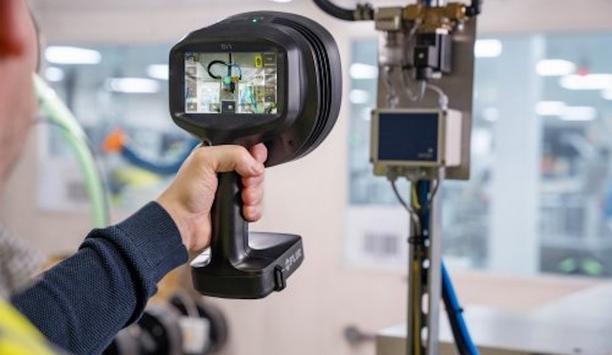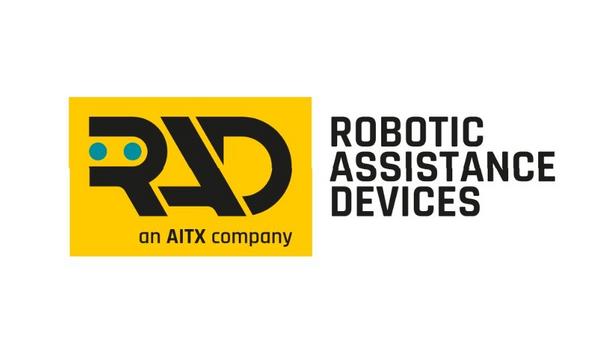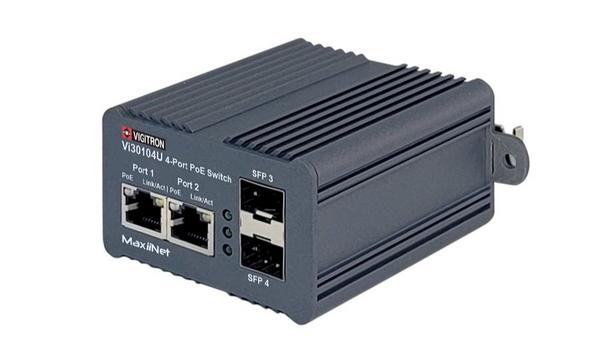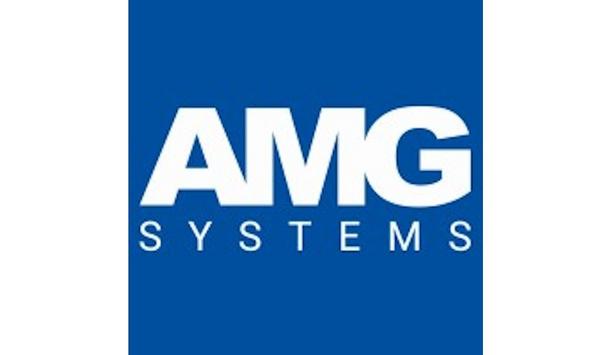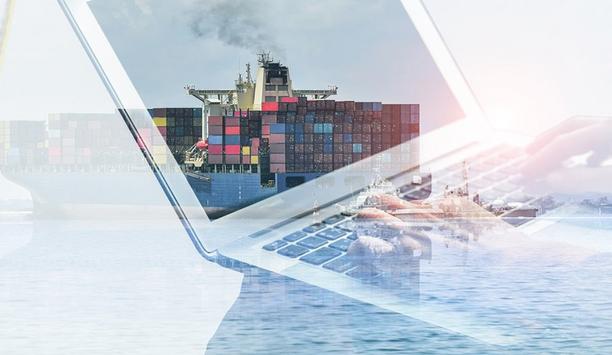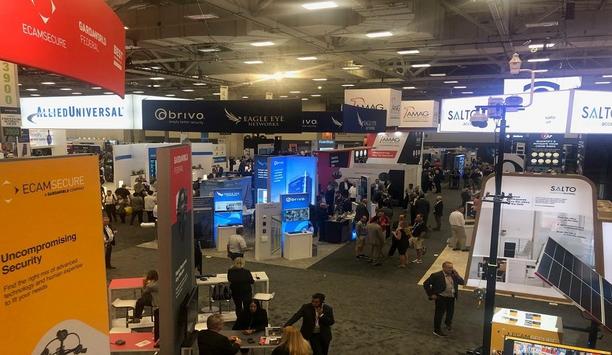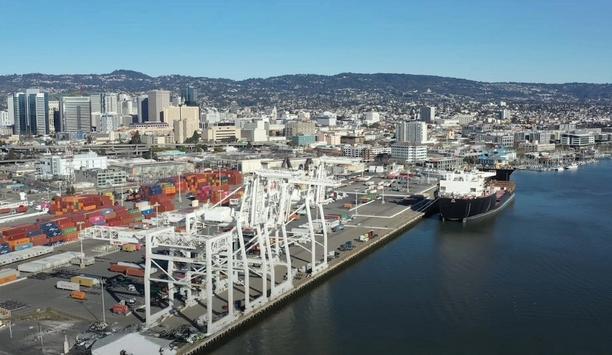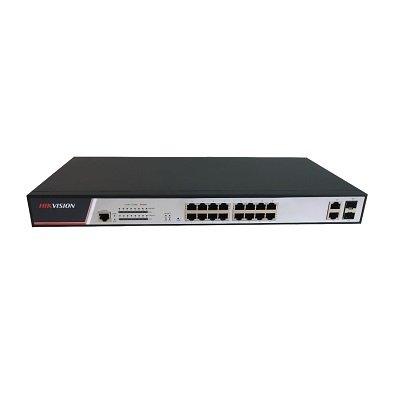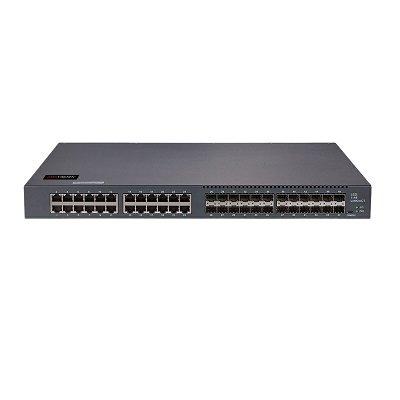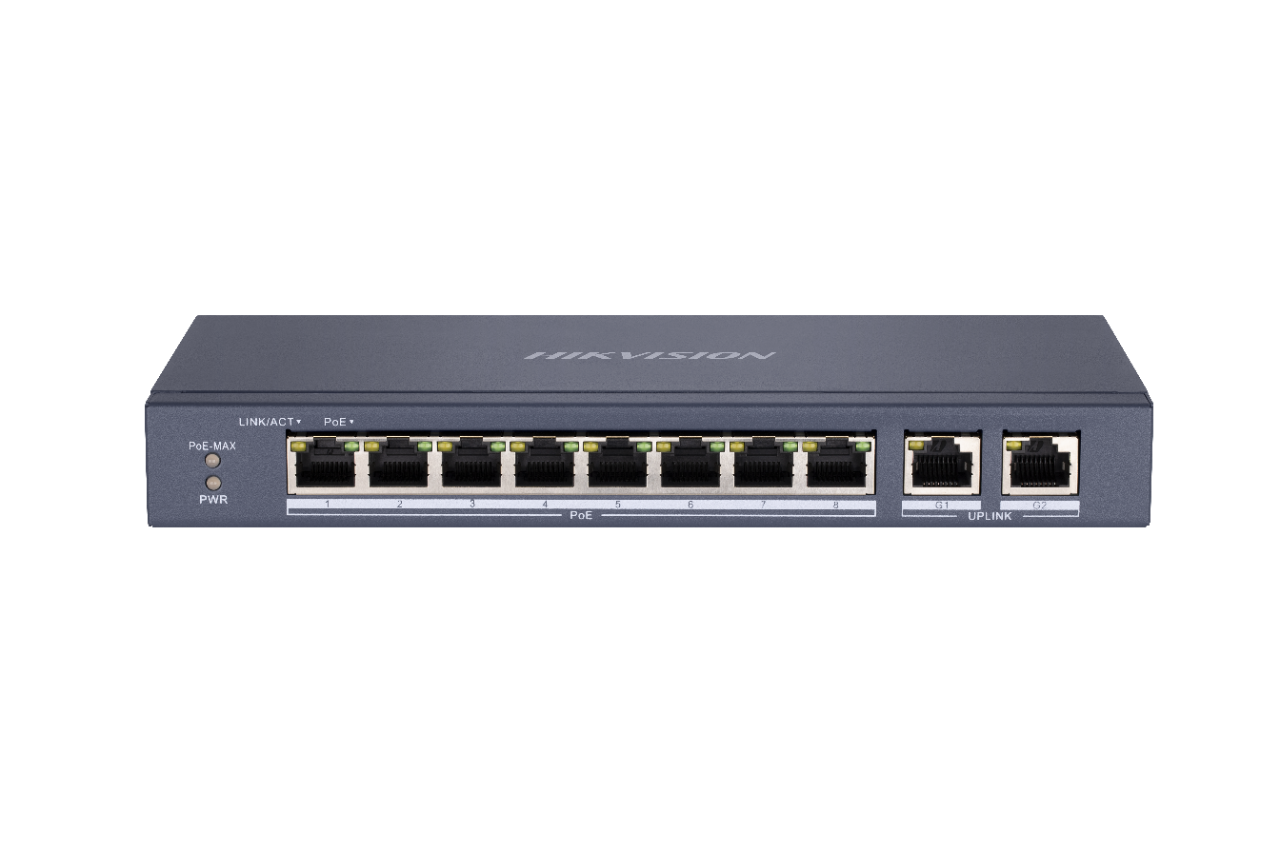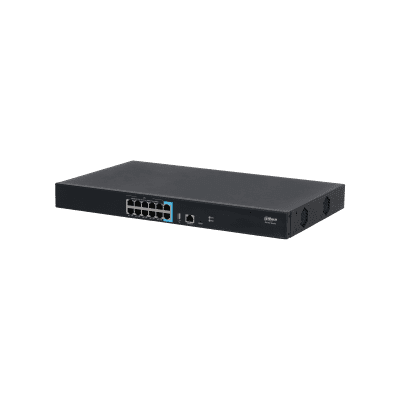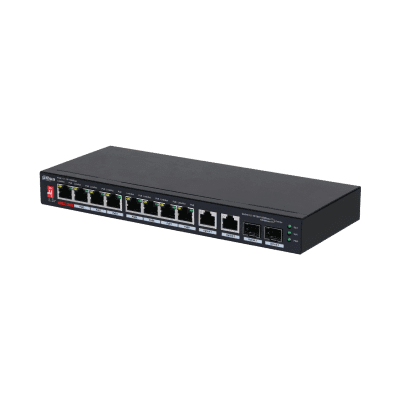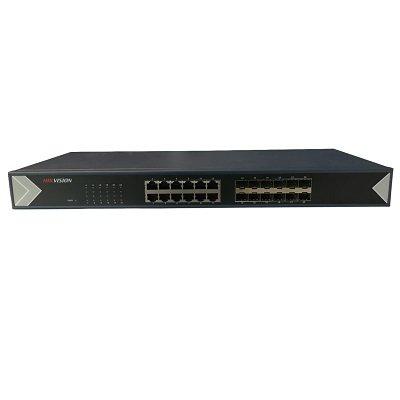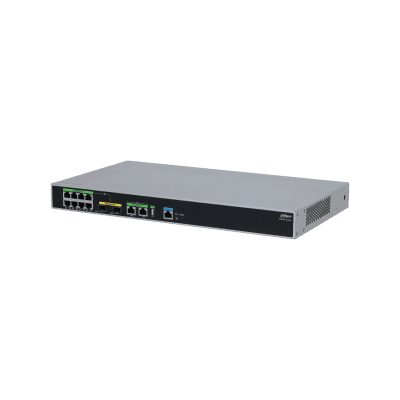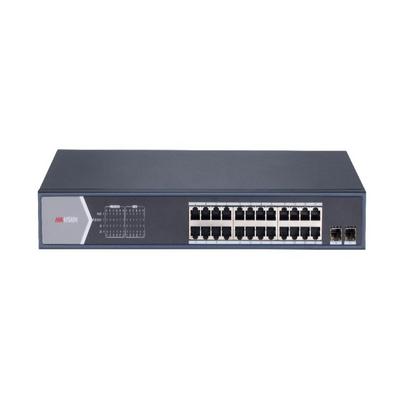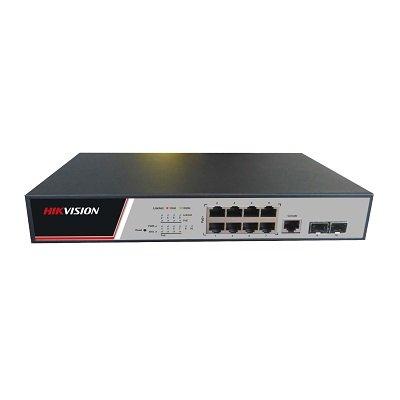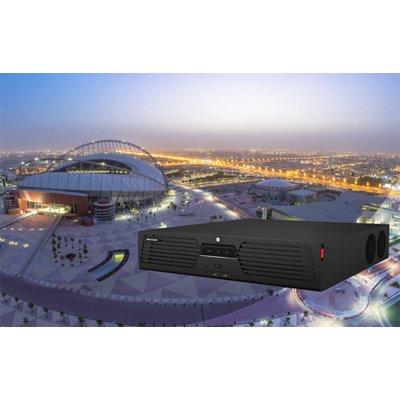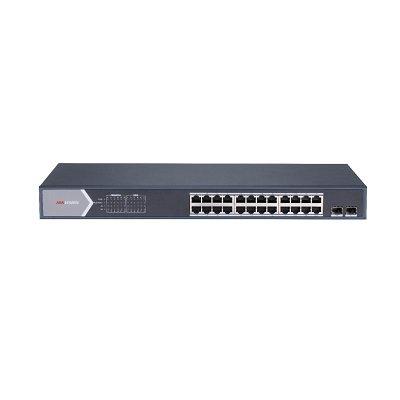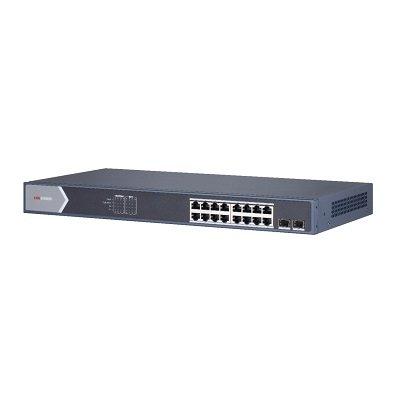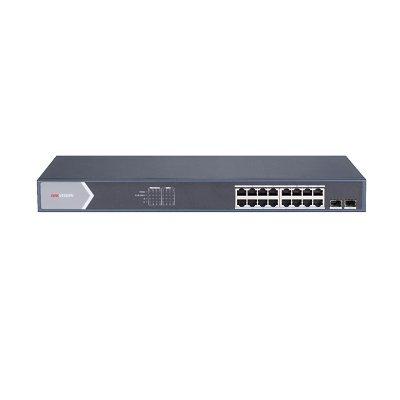Coastal surveillance
LOOKOUT, a pioneering provider of marine AI systems for safety, announced the expansion of its product line by introducing a new camera featuring an integrated navigation light. This new camera system offers enhanced safety and greater installation flexibility and is available in LOOKOUT's classic blue and white, matte black with carbon accents and custom colours by request, to complement a wider range of vessel designs. Advanced AI vision cameras LOOKOUT has solved a common installation dile...
Omada by TP-Link and VIGI by TP-Link, TP-Link Systems Inc.’s exclusive business solutions brands, are set to make waves at ISC West 2025 with the debut of their groundbreaking unified networking and surveillance solutions. At the event, the brands will showcase a seamless integration of VIGI’s cutting-edge surveillance solutions, Omada’s comprehensive networking systems, and the Omada Central platform—a revolutionary cloud-based solution that unifies the management of ne...
FLIR, a Teledyne Technologies company, is set to showcase its maintenance portfolio at Maintenance NEXT from April 8 to 10 in Rotterdam. FLIR Si1-LD acoustic camera FLIR’s main highlight at Maintenance NEXT will be the new Si1-LD industrial acoustic imaging camera, which brings faster and more accurate compressed air leak detection to those operating on a limited condition monitoring budget. Si1-LD offers improved detection and quantification capabilities in comparison with the existing...
Sielox LLC President and CEO Karen Evans announced its annual Certified Sielox Integrators Award recipients for 2024. For the 30th time overall, MCM Integrated Systems of Van Nuys, California, was awarded National Certified Sielox Integrator of the Year. Sielox access control software “MCM Integrated has a remarkable 26 consecutive years of commitment to Sielox access control software and controllers,” said Evans. “Rich McMillan and his team define what experts are when it...
Apricorn, the pioneer manufacturer of software-free, 256-bit AES XTS hardware-encrypted USB data storage devices, announced the release of the Aegis Thunderbolt 4 Docking Station, designed to maximise connectivity, integration and efficiency. The docking station powers multiple peripherals at once and delivers high-speed data transfer through its integrated Thunderbolt ports, offering reliability, versatility and security for the flexible workforce. Powering hybrid work As businesses continue...
Eagle Eye Networks, the global pioneer in cloud video surveillance, launched Eagle Eye Automations. A flexible and extensible rules engine for automating tasks that empowers businesses to proactively and economically improve security, safety and business operations. Simplifying security management “Today’s security systems are complex, increasingly incorporating video surveillance, AI, analytics, sensors, and other third-party devices and technologies. Eagle Eye Automations enable...
News
The Security Industry Association (SIA) has named new members and leadership of the steering committee for SIA RISE, a community that fosters the careers of young professionals and emerging pioneers in the security industry. Dakota Mackie of Northland Controls serves as chair, with Kelly Ann Christensen of BCD now serving as vice chair. In these roles, Mackie and Christensen ensure that RISE delivers educational content and networking opportunities to young professional employees and rising stars at SIA member companies, college students and recent graduates interested in the global security industry. Prior roles of Mackie Mackie joined Northland Controls in 2020 as the content marketing specialist Dakota Mackie is the business development manager at Northland Controls. Prior to joining the security industry, she worked as a client services coordinator at the Washington Commanders (then the Washington Redskins) before beginning a role with a military nonprofit, Luke’s Wings, where she ultimately ended her tenure as the executive director. Mackie joined Northland Controls in 2020 as the content marketing specialist, and in her current role, she is responsible for supporting the entire sales cycle with a focus on the growth of Northland’s managed services offering. Mackie has been honoured as a SIA Women in Security Forum Power 100 honouree and is a graduate of the University of South Carolina. Outside of work, she has a passion for travelling the world and learning about new cultures. Prior roles of Ann Christensen Kelly Ann Christensen is a digital marketing specialist at BCD, an IP video data infrastructure manufacturer, and has spent nearly five years specialising in the security industry. With a focus on digital advertising and marketing analytics, she has certifications in ROI marketing, marketing management, SEO and PPC marketing. Prior to becoming RISE vice chair, she served as head of the RISE Scholarship subcommittee, which provides scholarships to young professionals in the security industry to assist with furthering education, attending industry events, obtaining new certifications and furthering their professional development, and was awarded the SIA RISE Scholarship in 2022 and one of SIA’s 2024 Sandy Jones Volunteers of the Year. Christensen has also participated in SIA’s Talent Inclusion Mentorship Education (TIME) program, which is designed to promote diversity, equity, inclusion and empowerment of underrepresented identities in the security industry by creating a well-defined pathway for learning and development. SIA RISE Steering Committee The SIA RISE Steering Committee now includes the following members: Chair: Dakota Mackie, business development manager, Northland Controls (Term ends 2025) Vice Chair: Kelly Ann Christensen, marketing manager, BCD (Term ends 2027) AcceleRISE Subcommittee Chair: Erin Grippo, senior manager, product operations, Brivo (Term ends 2025) Content Subcommittee Chair: Tanner LaRocque, marketing director, Evolon (Term ends 2026) Scholarship Subcommittee Chair: Kristin Shockley, manager, segment marketing, Genetec (Term ends 2026) Diversity, Equity & Inclusion Subcommittee Chair: Tristin Vaccaro, owner, Vaccaro Copywriting & Marketing Solutions (Term ends 2025) Jonah Azarcon, deputy project pioneer, M.C. Dean (Term ends 2027) Krystina Beach, marketing communications manager, ASSA ABLOY (Term ends 2027) Andres Capous, regional sales manager, Velasea (Term ends 2027) Joey Joy, distribution channel account manager, March Networks (Term ends 2027) Ryan Knoll, business relations manager, Pro-Tec Design (Term ends 2027) Tim Loth, sales engineer team lead, i-PRO (Term ends 2026) Jackie Paryz, director, sales, technology solutions, Securitas (Term ends 2027) Itzel Portillo, marketing specialist, Allegion (Term ends 2027) Amanda Powell, marketing manager, Boon Edam (Term ends 2025) Nicole Rigby, team lead, distribution operations, Axis Communications (Term ends 2026) Keyser Santana, global security strategist and business execution senior manager, Pratt & Whitney (Term ends 2025) Constantine Tremouliaris, integrated solutions specialist, ASSA ABLOY (Term ends 2025) KeShia Thomas, brand and solutions manager, Allegion (Term ends 2027) Mfon Ubaha, business development manager, i-PRO (Term ends 2027) Sarah Webel, human resources generalist, SAGE Integration (Term ends 2027) Lauren Yonis, global events manager, acre (Term ends 2027) New RISE committee members “SIA RISE is a vibrant community of accomplished young security pioneers and driven industry newcomers that offers a robust array of opportunities for learning, professional development, engagement and relationship building in our industry. This community and its meaningful initiatives would not be possible without our dedicated, talented volunteers, like RISE chair Dakota Mackie, new vice chair Kelly Ann Christensen and our subcommittee chairs, Erin Grippo, Tanner LaRocque, Kristin Shockley and Tristin Vaccaro,” said SIA CEO Don Erickson. “We welcome our new RISE committee members, and we thank outgoing committee members and past RISE chairs Jake Brown and Matt Feenan for their leadership and support over the years. We look forward to working together with the 2025 RISE committee to further advance the reach and impact of RISE and its programs and propel the security workforce of the future.” RISE Awards and annual AcceleRISE conference SIA RISE is a community that fosters the careers of young professionals in the security industry. SIA RISE’s offerings include an annual scholarship to further young talent’s education and career goals, fun in-person and virtual networking events for young professionals, the TIME program for early and mid-career professionals, recognition of new and emerging industry pioneers through the 25 on the RISE Awards and the annual AcceleRISE conference – an essential experience for young security talent. The SIA RISE community is open to all employees at SIA member companies who are young professionals under 40 or have been in the security industry for less than two years.
The International Maritime Cyber Security Organisation (IMCSO), an independent maritime standards organisation, has released its cybersecurity testing methodology for those maritime vessels looking to assess their risk and join the Cyber Risk Registry, a risk register database maintained by the IMCSO. The methodology aims to provide IMCSO-accredited cyber consultants and the senior maritime personnel they will be assessing with standardised testing by outlining test scope and the language to be used to ensure tests are planned, executed and reported effectively. Quality of cyber risk assessments “Currently there is no standard in the maritime sector for governing the quality of cyber risk assessments. This methodology will set a precedent by providing a set of criteria that assessors must observe when on engagement and against which maritime security can be measured." "It is a very big step forward in normalising both expectations and requirements in the maritime space,” said Campbell Murray, CEO at the IMCSO. Guide for cybersecurity practitioners The methodology stipulates the needs under which the cybersecurity checks will be carried out The methodology stipulates the conditions under which the cybersecurity assessments will be carried out. It acts as a legal and practical guide for cybersecurity practitioners who must adhere to the standards as a condition of their inclusion on the approved suppliers list, otherwise known as the Certified Supplier Registry, held by the IMCSO. The Captain and crew undergoing the assessment will also be required to abide by the methodology and undergo pre-assessment training to become cyber-ready in order to better understand the process and its findings. Operational technology standards Testing will assess security across ten categories under the umbrella term of Operational Technology (OT), i.e., the hardware and software needed to monitor and control the physical processes of the ship. These include navigation, propulsion, electrical systems, communication, safety systems, cargo handling, environmental systems, and maintenance systems, human factors, and regulatory and compliance issues. The assessment may be carried out at sea, onshore or a combination of the two. Currently, the only OT standards available to the sector are those associated with the manufacturing industry and very few directly assess OT. Cybersecurity posture In addition, it can often be difficult for shipping companies to objectively assess their OT suppliers In addition, it can often be difficult for shipping companies to objectively assess their OT suppliers, as Murray explains: “Third parties and the shipping companies share a dependency, with joint goals and integrated operations." "Yet, with supply chain attacks on the rise, they represent a real risk to operations. This can strain the relationship but by applying a systematic approach through a standardised risk assessment, the company can rely upon the process to vet the cybersecurity posture of their suppliers for them.” Key components of the IMCSO security testing methodology Pre-Requisites: Rules of engagement, authorisation, scope of work, objectives, zones of testing. Scope of Work: Outlines the project details and goals, signed by both parties. Rules of Engagement: Guidelines for testing, including permitted hours and restrictions. Authorisation and Legal Considerations: Compliance with laws and written stakeholder approval. Testing Methodology: The approach used (e.g., black-box, white-box). Deliverables: Expected outputs, such as reports and recommendations. Timelines: Start and end dates, with key milestones. Communication Plan: Points of contact and reporting protocols. Risk Management and Contingency Planning: Plans to mitigate potential risks like downtime or data loss. Confidentiality and Data Handling: Protecting sensitive data and results Testing Activity: Performed by qualified personnel, with prompt reporting of critical issues. Reporting: Clear and categorised reporting of security findings, including solutions. Report Delivery: Secure and confidential delivery of the final report. Cyber risk of the vessel Reports will take a practical method with clear advice made in response to any security issues Reports will take a practical approach with clear recommendations made in response to any of security issues or vulnerabilities. Outputs will be standardised under the methodology using qualitative metrics and this consistency will ensure the results for each vessel are comparable. The results will be used to profile the cyber risk of the vessel, the status of which will be recorded in the Cyber Risk Registry. Cyber risk trends within the maritime sector Shipowners are sensitive about sharing their vessel's data. The Cyber Risk Registry will serve as a valuable resource for stakeholders and relevant parties, including port authorities, insurance companies, and association partners, by providing insights into cyber risk trends within the maritime sector. Additionally, it will support the broader industry—including the IMO, shipbuilders, management companies, and industry associations—by offering a trusted registry of vendors, qualified practitioners, and service providers to help vessels strengthen their cyber resilience and mitigate risks effectively.
Playhouse Square is a jewel of Northeast Ohio. Thousands of people live, work, and visit the area. “We want to make sure whoever the resident is, whoever the visitor is, they’re having the same great experience day in and day out,” said Nathan Kelly, President of Playhouse Square Real Estate. ROSA Safety is part of that experience. Last October, ROSA, a remote observation security agent, moved into Public Square. Equipped with AI technology, ROSA never blinks and can issue verbal warnings to deter criminal activity in real time. Now, the high-tech cameras are expanding to Playhouse Square. “The new cameras will be mounted to be able to look at all areas around Playhouse District more discreetly,” added Kelly. Real-Time Crime Center The combination of high-tech cameras, as well as dedicated police officers assigned to Public Square Developed by Robotic Assistance Devices (RAD), these cameras are linked to Cleveland’s Real-Time Crime Center, but they are also monitored by Downtown Cleveland Inc. ambassadors in their headquarters from 7 a.m. until midnight. Ed Eckart, Senior Vice President of Operations at Downtown Cleveland Inc., said that the combination of high-tech cameras, as well as other security measures like dedicated police officers assigned to Public Square, has led to a significantly improved environment. Drop in crime rates “Both the statistics bear that out but also the feedback we’re getting from residents, visitors, property owners, they have shared with us that the environment here is noticeably better, ” added Eckart. While specific crime statistics for Public Square are not available, Eckart said there is a 12% decrease in serious crimes in the area and a 34% drop in crimes like car break-ins in the surrounding neighbourhoods. Smart camera network “Our goal is to have a network of these smart cameras throughout all of downtown,” he says. By spring, there are expected to be a dozen cameras operating, all of which will be monitored from the Downtown Cleveland Inc. headquarters. Two extra cameras will be placed in Public Square and four at North Coast Harbor.
iDenfy, a global pioneer in identity verification and fraud prevention, announced a new partnership with Coast, an innovative blockchain platform simplifying crypto-to-fiat transactions on PulseChain. This partnership will focus on enhancing security and streamlining KYC/AML compliance processes while boosting the platform’s security and addressing critical challenges in the blockchain ecosystem. Securing decentralised finance This partnership represents a crucial step forward, equipping Coast with advanced tools Global money laundering remains a common issue, with an estimated $2. trillion laundered annually, according to the United Nations. As financial crimes grow, platforms operating at the intersection of blockchain and traditional finance face increasing pressure to meet stringent compliance standards. This partnership represents a crucial step forward, equipping Coast with advanced tools to navigate the complexities of regulatory frameworks while fostering trust and security in the decentralised finance sector. Blockchain security simplified Coast has established itself as a pioneer in blockchain technology and financial services by offering a seamless and compliant gateway for users to interact with PulseChain. The platform's mission is to create user-centric financial solutions tailored for the decentralised future while maintaining the highest standards of security and compliance. To achieve this, Coast has partnered with iDenfy, a company known for its robust identity verification and Anti-Money Laundering (AML) tools that meet global compliance requirements. Secure identity verification Through this collaboration, iDenfy will bring its innovative identity verification solution, ensuring precise and secure onboarding for all users. iDenfy’s technology automatically recognises, verifies, and extracts information from more than 3,000 types of identity documents across more than 200 countries and territories. From passports and ID cards to driving licences and residence permits. The solution also includes the integration of iDenfy’s advanced biometric facial recognition and 3D liveness detection technology to prevent fraudulent activities, such as the use of fake images, face masks, or digital renderings. By creating three-dimensional facial maps, iDenfy provides a secure method for user authentication, ensuring the verification process is both seamless and bulletproof. Scalable fraud prevention Coast can now conduct ongoing monitoring and receive instant notifications of any AML risk hits during the KYC process The partnership offers Coast a scalable system that reduces onboarding time while ensuring full compliance with global AML regulations. This includes screening users against sanctions lists, Politically Exposed Persons (PEPs), watchlists, and adverse media sources. By integrating iDenfy’s technology, Coast can now conduct ongoing monitoring and receive instant notifications of any AML risk hits during the KYC process. iDenfy’s solutions have already transformed Coast’s operations, offering a near-perfect verification success rate of 99.99%. Secure and compliant The high level of accuracy is supported by a team of expert reviewers who oversee all automated ID verifications to eliminate potential system errors, fraud attempts, or failures. In addition to its technological capabilities, iDenfy’s software is fully compliant with GDPR, CCPA, and SOC 2 standards, ensuring that businesses can operate with confidence in its data security and privacy practices. Providing financial security For Coast, the ability to deliver a seamless onboarding experience without compromising security is a top priority. The platform aims to bridge the gap between traditional financial systems and blockchain technology, empowering users to interact with decentralised systems easily and securely. With iDenfy’s solutions, Coast has not only improved its onboarding process but also enhanced user trust by ensuring compliance with the latest global regulations. Before partnering with iDenfy, Coast faced challenges in delivering a fast, user-friendly identity verification process while maintaining robust security standards. Innovation in verification iDenfy’s scalable solutions have resolved these issues, significantly improving operational efficiency and user trust. This partnership aligns perfectly with the mission to create a seamless and inclusive experience for PulseChain. Domantas Ciulde, CEO of iDenfy, said, “Blockchain platforms like Coast are paving the way for the future of finance. Our advanced identity verification and AML screening tools ensure that Coast’s users can confidently engage with PulseChain while maintaining compliance with global regulations. We’re proud to support Coast in creating a secure and innovative platform.” Faster and safer onboarding The integration of iDenfy’s tools has also transformed the user experience for Coast’s clients. The streamlined KYC process is now a simple, three-step procedure that takes less than a minute on average to complete. This efficiency ensures that users can quickly access Coast’s services without unnecessary delays, positioning the platform as a pioneer in user-centric blockchain solutions.
Vigitron, Inc., a global pioneer in network solutions for security applications, is pleased to announce the launch of the Vi30104U, a cost-effective 4-port fixed L2 unmanaged PoE switch designed to meet the growing demands of high-power PoE and high-speed data in security projects. The Vi30104U features two 1G 90W PoE ports compliant with the IEEE 802.3bt standard and offers backward compatibility with most legacy, non-standard high-power PoE devices. The switch also includes two 1G SFP fiber ports for uplink or daisy-chaining applications, providing flexible integration into a wide range of network topologies. Providing flexible integration With its compact design and high output capability, the Vi30104U is a perfect fit for remote deployments—including poles, perimeter fences, and infrastructure expansions—where power and connectivity must be extended efficiently and reliably. Key Features & Benefits: High-Speed & Long-Distance Connectivity – Supports fiber transmission up to 80 km Power Efficiency – Two ports deliver IEEE 802.3af/at/bt up to 90W PoE per port Intelligent Power Allocation – Auto PoE sensing, prioritization & overload protection Extreme Durability – Operates in -40°C to 70°C for harsh environments Ideal Applications: Cost-effective fiber & copper network expansion High-bandwidth multi-sensor & PTZ cameras Drop-and-insert configurations for long-distance camera transmission
AMG Systems of the United Kingdom and USA introduced the AMG260B/AMG2036 Blade Chassis System. The AMG260B blade cards are designed for installation in the AMG2036 blade chassis system, which accommodates up to 18 individual blade cards within a single 1U of 19-inch rack space. Additional models for the future This configuration offers industry-pioneering rack density, where space is limited, and the blade cards' hot-swap capability facilitates easy future expansion and device maintenance or replacement. Within the lineup, models are available with one TX port in, one FX SFP port out, and two TX ports in, one FX SFP port out, with additional models planned for the future. AMG260B series media converters AMG260B series media converters are ideally suited for connecting equipment to Ethernet networks Designed as ultra-compact blade cards, the AMG260B series media converters are ideally suited for connecting equipment to Ethernet networks over long distances using multimode or single-mode optical fibre through the integrated SFP port. Fibre connectivity is determined by separate SFP device selection, providing application and site flexibility. The AMG260B uses a dual-speed 100Mb/1Gb SFP port for connectivity, and AMG offers a wide range of SFPs for fibre, connector type, and distance. TAA and NDAA compliant The AMG260B Series media converters are designed in the USA and UK and manufactured in an ISO9001-certified UK facility, are designed to NEMA standards and are fully TAA and NDAA compliant, and unlike similar products from other Asian countries, can be used in all US Government installations. Steve Clarke, AMG's Managing Director, said, “AMG is known for our innovative approach to product design. With space being at a premium in most installations, the AMG260B/AMG2036 Blade Chassis System solves density challenges by allowing a large number of media converters to occupy a small amount of space in a standard 19-inch rack.” AMG260B/AMG2036 Blade Chassis System AMG260B Series media converters are designed in USA and UK and manufactured in the UK facility Clarke concluded: “Our unparalleled manufacturing process allows AMG to offer a wide range of transmission products at very cost-effective levels while maintaining ISO9001 quality, the AMG260B/AMG2036 Blade Chassis System is another example.” Tom Exley, AMG Technical Director, adds, “The AMG260B/AMG2036 Blade Chassis System continues our quality standard. Our sales team and engineering team looked at what was available, identified installation density challenges, and engineered the AMG260B/AMG2036 Blade Chassis System to overcome those weaknesses." Added layer of security Exley added: "The AMG260B builds off the successful AMG 260M Series media converter and transforms it into the blade format. This media converter system solves the density challenge, allowing the user to utilise more devices in a smaller area." "The AMG 260B is made in an ISO9001-certified facility and, most importantly, is available when needed. We believe in the quality and stand behind them with lifetime support. Plus having a product made in the UK gives your network an added layer of security.” AMG Lifetime Warranty AMG believes having products in stock, being fully supported by the AMG design team, and being covered by the AMG Lifetime Warranty gives AMG customers worldwide a measurable advantage in the competitive marketplace. AMG Systems offers an extensive line of fibre optic, copper, and wireless Ethernet, video, and data transmission equipment that is uniquely designed to meet the needs of the Security, Intelligent Transportation Systems, Utility, and Industrial markets.
The Security Industry Association (SIA) has named new members and leadership of the steering committee for SIA RISE, a community that fosters the careers of young professionals and emerging pioneers in the security industry. Dakota Mackie of Northland Controls serves as chair, with Kelly Ann Christensen of BCD now serving as vice chair. In these roles, Mackie and Christensen ensure that RISE delivers educational content and networking opportunities to young professional employees and rising stars at SIA member companies, college students and recent graduates interested in the global security industry. Prior roles of Mackie Mackie joined Northland Controls in 2020 as the content marketing specialist Dakota Mackie is the business development manager at Northland Controls. Prior to joining the security industry, she worked as a client services coordinator at the Washington Commanders (then the Washington Redskins) before beginning a role with a military nonprofit, Luke’s Wings, where she ultimately ended her tenure as the executive director. Mackie joined Northland Controls in 2020 as the content marketing specialist, and in her current role, she is responsible for supporting the entire sales cycle with a focus on the growth of Northland’s managed services offering. Mackie has been honoured as a SIA Women in Security Forum Power 100 honouree and is a graduate of the University of South Carolina. Outside of work, she has a passion for travelling the world and learning about new cultures. Prior roles of Ann Christensen Kelly Ann Christensen is a digital marketing specialist at BCD, an IP video data infrastructure manufacturer, and has spent nearly five years specialising in the security industry. With a focus on digital advertising and marketing analytics, she has certifications in ROI marketing, marketing management, SEO and PPC marketing. Prior to becoming RISE vice chair, she served as head of the RISE Scholarship subcommittee, which provides scholarships to young professionals in the security industry to assist with furthering education, attending industry events, obtaining new certifications and furthering their professional development, and was awarded the SIA RISE Scholarship in 2022 and one of SIA’s 2024 Sandy Jones Volunteers of the Year. Christensen has also participated in SIA’s Talent Inclusion Mentorship Education (TIME) program, which is designed to promote diversity, equity, inclusion and empowerment of underrepresented identities in the security industry by creating a well-defined pathway for learning and development. SIA RISE Steering Committee The SIA RISE Steering Committee now includes the following members: Chair: Dakota Mackie, business development manager, Northland Controls (Term ends 2025) Vice Chair: Kelly Ann Christensen, marketing manager, BCD (Term ends 2027) AcceleRISE Subcommittee Chair: Erin Grippo, senior manager, product operations, Brivo (Term ends 2025) Content Subcommittee Chair: Tanner LaRocque, marketing director, Evolon (Term ends 2026) Scholarship Subcommittee Chair: Kristin Shockley, manager, segment marketing, Genetec (Term ends 2026) Diversity, Equity & Inclusion Subcommittee Chair: Tristin Vaccaro, owner, Vaccaro Copywriting & Marketing Solutions (Term ends 2025) Jonah Azarcon, deputy project pioneer, M.C. Dean (Term ends 2027) Krystina Beach, marketing communications manager, ASSA ABLOY (Term ends 2027) Andres Capous, regional sales manager, Velasea (Term ends 2027) Joey Joy, distribution channel account manager, March Networks (Term ends 2027) Ryan Knoll, business relations manager, Pro-Tec Design (Term ends 2027) Tim Loth, sales engineer team lead, i-PRO (Term ends 2026) Jackie Paryz, director, sales, technology solutions, Securitas (Term ends 2027) Itzel Portillo, marketing specialist, Allegion (Term ends 2027) Amanda Powell, marketing manager, Boon Edam (Term ends 2025) Nicole Rigby, team lead, distribution operations, Axis Communications (Term ends 2026) Keyser Santana, global security strategist and business execution senior manager, Pratt & Whitney (Term ends 2025) Constantine Tremouliaris, integrated solutions specialist, ASSA ABLOY (Term ends 2025) KeShia Thomas, brand and solutions manager, Allegion (Term ends 2027) Mfon Ubaha, business development manager, i-PRO (Term ends 2027) Sarah Webel, human resources generalist, SAGE Integration (Term ends 2027) Lauren Yonis, global events manager, acre (Term ends 2027) New RISE committee members “SIA RISE is a vibrant community of accomplished young security pioneers and driven industry newcomers that offers a robust array of opportunities for learning, professional development, engagement and relationship building in our industry. This community and its meaningful initiatives would not be possible without our dedicated, talented volunteers, like RISE chair Dakota Mackie, new vice chair Kelly Ann Christensen and our subcommittee chairs, Erin Grippo, Tanner LaRocque, Kristin Shockley and Tristin Vaccaro,” said SIA CEO Don Erickson. “We welcome our new RISE committee members, and we thank outgoing committee members and past RISE chairs Jake Brown and Matt Feenan for their leadership and support over the years. We look forward to working together with the 2025 RISE committee to further advance the reach and impact of RISE and its programs and propel the security workforce of the future.” RISE Awards and annual AcceleRISE conference SIA RISE is a community that fosters the careers of young professionals in the security industry. SIA RISE’s offerings include an annual scholarship to further young talent’s education and career goals, fun in-person and virtual networking events for young professionals, the TIME program for early and mid-career professionals, recognition of new and emerging industry pioneers through the 25 on the RISE Awards and the annual AcceleRISE conference – an essential experience for young security talent. The SIA RISE community is open to all employees at SIA member companies who are young professionals under 40 or have been in the security industry for less than two years.
The International Maritime Cyber Security Organisation (IMCSO), an independent maritime standards organisation, has released its cybersecurity testing methodology for those maritime vessels looking to assess their risk and join the Cyber Risk Registry, a risk register database maintained by the IMCSO. The methodology aims to provide IMCSO-accredited cyber consultants and the senior maritime personnel they will be assessing with standardised testing by outlining test scope and the language to be used to ensure tests are planned, executed and reported effectively. Quality of cyber risk assessments “Currently there is no standard in the maritime sector for governing the quality of cyber risk assessments. This methodology will set a precedent by providing a set of criteria that assessors must observe when on engagement and against which maritime security can be measured." "It is a very big step forward in normalising both expectations and requirements in the maritime space,” said Campbell Murray, CEO at the IMCSO. Guide for cybersecurity practitioners The methodology stipulates the needs under which the cybersecurity checks will be carried out The methodology stipulates the conditions under which the cybersecurity assessments will be carried out. It acts as a legal and practical guide for cybersecurity practitioners who must adhere to the standards as a condition of their inclusion on the approved suppliers list, otherwise known as the Certified Supplier Registry, held by the IMCSO. The Captain and crew undergoing the assessment will also be required to abide by the methodology and undergo pre-assessment training to become cyber-ready in order to better understand the process and its findings. Operational technology standards Testing will assess security across ten categories under the umbrella term of Operational Technology (OT), i.e., the hardware and software needed to monitor and control the physical processes of the ship. These include navigation, propulsion, electrical systems, communication, safety systems, cargo handling, environmental systems, and maintenance systems, human factors, and regulatory and compliance issues. The assessment may be carried out at sea, onshore or a combination of the two. Currently, the only OT standards available to the sector are those associated with the manufacturing industry and very few directly assess OT. Cybersecurity posture In addition, it can often be difficult for shipping companies to objectively assess their OT suppliers In addition, it can often be difficult for shipping companies to objectively assess their OT suppliers, as Murray explains: “Third parties and the shipping companies share a dependency, with joint goals and integrated operations." "Yet, with supply chain attacks on the rise, they represent a real risk to operations. This can strain the relationship but by applying a systematic approach through a standardised risk assessment, the company can rely upon the process to vet the cybersecurity posture of their suppliers for them.” Key components of the IMCSO security testing methodology Pre-Requisites: Rules of engagement, authorisation, scope of work, objectives, zones of testing. Scope of Work: Outlines the project details and goals, signed by both parties. Rules of Engagement: Guidelines for testing, including permitted hours and restrictions. Authorisation and Legal Considerations: Compliance with laws and written stakeholder approval. Testing Methodology: The approach used (e.g., black-box, white-box). Deliverables: Expected outputs, such as reports and recommendations. Timelines: Start and end dates, with key milestones. Communication Plan: Points of contact and reporting protocols. Risk Management and Contingency Planning: Plans to mitigate potential risks like downtime or data loss. Confidentiality and Data Handling: Protecting sensitive data and results Testing Activity: Performed by qualified personnel, with prompt reporting of critical issues. Reporting: Clear and categorised reporting of security findings, including solutions. Report Delivery: Secure and confidential delivery of the final report. Cyber risk of the vessel Reports will take a practical method with clear advice made in response to any security issues Reports will take a practical approach with clear recommendations made in response to any of security issues or vulnerabilities. Outputs will be standardised under the methodology using qualitative metrics and this consistency will ensure the results for each vessel are comparable. The results will be used to profile the cyber risk of the vessel, the status of which will be recorded in the Cyber Risk Registry. Cyber risk trends within the maritime sector Shipowners are sensitive about sharing their vessel's data. The Cyber Risk Registry will serve as a valuable resource for stakeholders and relevant parties, including port authorities, insurance companies, and association partners, by providing insights into cyber risk trends within the maritime sector. Additionally, it will support the broader industry—including the IMO, shipbuilders, management companies, and industry associations—by offering a trusted registry of vendors, qualified practitioners, and service providers to help vessels strengthen their cyber resilience and mitigate risks effectively.
Playhouse Square is a jewel of Northeast Ohio. Thousands of people live, work, and visit the area. “We want to make sure whoever the resident is, whoever the visitor is, they’re having the same great experience day in and day out,” said Nathan Kelly, President of Playhouse Square Real Estate. ROSA Safety is part of that experience. Last October, ROSA, a remote observation security agent, moved into Public Square. Equipped with AI technology, ROSA never blinks and can issue verbal warnings to deter criminal activity in real time. Now, the high-tech cameras are expanding to Playhouse Square. “The new cameras will be mounted to be able to look at all areas around Playhouse District more discreetly,” added Kelly. Real-Time Crime Center The combination of high-tech cameras, as well as dedicated police officers assigned to Public Square Developed by Robotic Assistance Devices (RAD), these cameras are linked to Cleveland’s Real-Time Crime Center, but they are also monitored by Downtown Cleveland Inc. ambassadors in their headquarters from 7 a.m. until midnight. Ed Eckart, Senior Vice President of Operations at Downtown Cleveland Inc., said that the combination of high-tech cameras, as well as other security measures like dedicated police officers assigned to Public Square, has led to a significantly improved environment. Drop in crime rates “Both the statistics bear that out but also the feedback we’re getting from residents, visitors, property owners, they have shared with us that the environment here is noticeably better, ” added Eckart. While specific crime statistics for Public Square are not available, Eckart said there is a 12% decrease in serious crimes in the area and a 34% drop in crimes like car break-ins in the surrounding neighbourhoods. Smart camera network “Our goal is to have a network of these smart cameras throughout all of downtown,” he says. By spring, there are expected to be a dozen cameras operating, all of which will be monitored from the Downtown Cleveland Inc. headquarters. Two extra cameras will be placed in Public Square and four at North Coast Harbor.
iDenfy, a global pioneer in identity verification and fraud prevention, announced a new partnership with Coast, an innovative blockchain platform simplifying crypto-to-fiat transactions on PulseChain. This partnership will focus on enhancing security and streamlining KYC/AML compliance processes while boosting the platform’s security and addressing critical challenges in the blockchain ecosystem. Securing decentralised finance This partnership represents a crucial step forward, equipping Coast with advanced tools Global money laundering remains a common issue, with an estimated $2. trillion laundered annually, according to the United Nations. As financial crimes grow, platforms operating at the intersection of blockchain and traditional finance face increasing pressure to meet stringent compliance standards. This partnership represents a crucial step forward, equipping Coast with advanced tools to navigate the complexities of regulatory frameworks while fostering trust and security in the decentralised finance sector. Blockchain security simplified Coast has established itself as a pioneer in blockchain technology and financial services by offering a seamless and compliant gateway for users to interact with PulseChain. The platform's mission is to create user-centric financial solutions tailored for the decentralised future while maintaining the highest standards of security and compliance. To achieve this, Coast has partnered with iDenfy, a company known for its robust identity verification and Anti-Money Laundering (AML) tools that meet global compliance requirements. Secure identity verification Through this collaboration, iDenfy will bring its innovative identity verification solution, ensuring precise and secure onboarding for all users. iDenfy’s technology automatically recognises, verifies, and extracts information from more than 3,000 types of identity documents across more than 200 countries and territories. From passports and ID cards to driving licences and residence permits. The solution also includes the integration of iDenfy’s advanced biometric facial recognition and 3D liveness detection technology to prevent fraudulent activities, such as the use of fake images, face masks, or digital renderings. By creating three-dimensional facial maps, iDenfy provides a secure method for user authentication, ensuring the verification process is both seamless and bulletproof. Scalable fraud prevention Coast can now conduct ongoing monitoring and receive instant notifications of any AML risk hits during the KYC process The partnership offers Coast a scalable system that reduces onboarding time while ensuring full compliance with global AML regulations. This includes screening users against sanctions lists, Politically Exposed Persons (PEPs), watchlists, and adverse media sources. By integrating iDenfy’s technology, Coast can now conduct ongoing monitoring and receive instant notifications of any AML risk hits during the KYC process. iDenfy’s solutions have already transformed Coast’s operations, offering a near-perfect verification success rate of 99.99%. Secure and compliant The high level of accuracy is supported by a team of expert reviewers who oversee all automated ID verifications to eliminate potential system errors, fraud attempts, or failures. In addition to its technological capabilities, iDenfy’s software is fully compliant with GDPR, CCPA, and SOC 2 standards, ensuring that businesses can operate with confidence in its data security and privacy practices. Providing financial security For Coast, the ability to deliver a seamless onboarding experience without compromising security is a top priority. The platform aims to bridge the gap between traditional financial systems and blockchain technology, empowering users to interact with decentralised systems easily and securely. With iDenfy’s solutions, Coast has not only improved its onboarding process but also enhanced user trust by ensuring compliance with the latest global regulations. Before partnering with iDenfy, Coast faced challenges in delivering a fast, user-friendly identity verification process while maintaining robust security standards. Innovation in verification iDenfy’s scalable solutions have resolved these issues, significantly improving operational efficiency and user trust. This partnership aligns perfectly with the mission to create a seamless and inclusive experience for PulseChain. Domantas Ciulde, CEO of iDenfy, said, “Blockchain platforms like Coast are paving the way for the future of finance. Our advanced identity verification and AML screening tools ensure that Coast’s users can confidently engage with PulseChain while maintaining compliance with global regulations. We’re proud to support Coast in creating a secure and innovative platform.” Faster and safer onboarding The integration of iDenfy’s tools has also transformed the user experience for Coast’s clients. The streamlined KYC process is now a simple, three-step procedure that takes less than a minute on average to complete. This efficiency ensures that users can quickly access Coast’s services without unnecessary delays, positioning the platform as a pioneer in user-centric blockchain solutions.
Vigitron, Inc., a global pioneer in network solutions for security applications, is pleased to announce the launch of the Vi30104U, a cost-effective 4-port fixed L2 unmanaged PoE switch designed to meet the growing demands of high-power PoE and high-speed data in security projects. The Vi30104U features two 1G 90W PoE ports compliant with the IEEE 802.3bt standard and offers backward compatibility with most legacy, non-standard high-power PoE devices. The switch also includes two 1G SFP fiber ports for uplink or daisy-chaining applications, providing flexible integration into a wide range of network topologies. Providing flexible integration With its compact design and high output capability, the Vi30104U is a perfect fit for remote deployments—including poles, perimeter fences, and infrastructure expansions—where power and connectivity must be extended efficiently and reliably. Key Features & Benefits: High-Speed & Long-Distance Connectivity – Supports fiber transmission up to 80 km Power Efficiency – Two ports deliver IEEE 802.3af/at/bt up to 90W PoE per port Intelligent Power Allocation – Auto PoE sensing, prioritization & overload protection Extreme Durability – Operates in -40°C to 70°C for harsh environments Ideal Applications: Cost-effective fiber & copper network expansion High-bandwidth multi-sensor & PTZ cameras Drop-and-insert configurations for long-distance camera transmission
AMG Systems of the United Kingdom and USA introduced the AMG260B/AMG2036 Blade Chassis System. The AMG260B blade cards are designed for installation in the AMG2036 blade chassis system, which accommodates up to 18 individual blade cards within a single 1U of 19-inch rack space. Additional models for the future This configuration offers industry-pioneering rack density, where space is limited, and the blade cards' hot-swap capability facilitates easy future expansion and device maintenance or replacement. Within the lineup, models are available with one TX port in, one FX SFP port out, and two TX ports in, one FX SFP port out, with additional models planned for the future. AMG260B series media converters AMG260B series media converters are ideally suited for connecting equipment to Ethernet networks Designed as ultra-compact blade cards, the AMG260B series media converters are ideally suited for connecting equipment to Ethernet networks over long distances using multimode or single-mode optical fibre through the integrated SFP port. Fibre connectivity is determined by separate SFP device selection, providing application and site flexibility. The AMG260B uses a dual-speed 100Mb/1Gb SFP port for connectivity, and AMG offers a wide range of SFPs for fibre, connector type, and distance. TAA and NDAA compliant The AMG260B Series media converters are designed in the USA and UK and manufactured in an ISO9001-certified UK facility, are designed to NEMA standards and are fully TAA and NDAA compliant, and unlike similar products from other Asian countries, can be used in all US Government installations. Steve Clarke, AMG's Managing Director, said, “AMG is known for our innovative approach to product design. With space being at a premium in most installations, the AMG260B/AMG2036 Blade Chassis System solves density challenges by allowing a large number of media converters to occupy a small amount of space in a standard 19-inch rack.” AMG260B/AMG2036 Blade Chassis System AMG260B Series media converters are designed in USA and UK and manufactured in the UK facility Clarke concluded: “Our unparalleled manufacturing process allows AMG to offer a wide range of transmission products at very cost-effective levels while maintaining ISO9001 quality, the AMG260B/AMG2036 Blade Chassis System is another example.” Tom Exley, AMG Technical Director, adds, “The AMG260B/AMG2036 Blade Chassis System continues our quality standard. Our sales team and engineering team looked at what was available, identified installation density challenges, and engineered the AMG260B/AMG2036 Blade Chassis System to overcome those weaknesses." Added layer of security Exley added: "The AMG260B builds off the successful AMG 260M Series media converter and transforms it into the blade format. This media converter system solves the density challenge, allowing the user to utilise more devices in a smaller area." "The AMG 260B is made in an ISO9001-certified facility and, most importantly, is available when needed. We believe in the quality and stand behind them with lifetime support. Plus having a product made in the UK gives your network an added layer of security.” AMG Lifetime Warranty AMG believes having products in stock, being fully supported by the AMG design team, and being covered by the AMG Lifetime Warranty gives AMG customers worldwide a measurable advantage in the competitive marketplace. AMG Systems offers an extensive line of fibre optic, copper, and wireless Ethernet, video, and data transmission equipment that is uniquely designed to meet the needs of the Security, Intelligent Transportation Systems, Utility, and Industrial markets.


Expert commentary
When a bomb detonated in the Port of Beirut, I had hundreds of employees under my care inside the blast zone. Within just two hours, I was able to determine who was impacted, understand their safety conditions, and share resources for on-the-ground support—all thanks to mobile technology. For Chief Security Officers, receiving calls like these launches a variety of protocols and necessary decision-making with the safety and security of people and assets as a top priority. And these calls are only becoming more common. Dependence on threat intelligence Mobile phones have dominated the post-COVID environment where people work from anywhere Threats ranging from natural disasters to geopolitical conflicts are becoming more frequent and complicate the responsibility organisations have in keeping their people safe. To meet these needs CSO’s are staying ahead of negative outcomes through creating a greater dependence on threat intelligence. In these times, effective, real-time risk management depends on hyper-local data from technology that is accessible, portable, and dynamic–such as cell phones. Mobile phones have revolutionised the way people live and work. They allow us all to walk around with a computer in our pocket, bringing the world to our fingertips and eliminating digital borders for over 90% of the world's population. Mobile phones have dominated the post-COVID environment where people work from anywhere and have geographically distributed teams but are also more vulnerable to threatening events. Mobile-friendly risk management platforms Mobile technology assigns workers with easy entry to data that can help keep them and their teams safe As we approach 2024, many organisations are adopting comprehensive risk management tools that empower personnel across the organisation with the intelligence and knowledge they need to stay safe wherever they are. Mobile-friendly risk management platforms, such as Crisis24 Horizon, provide always-on awareness, on-hand threat intelligence, and immediate communications and distress signalling through location monitoring. Users receive location risk assessments and push notifications directly to their devices about nearby issues and threats no matter if they are on or off the job. While only select risk managers have complete control of the platform and all sensitive employee data is protected through encryption, the app distributes critical intel to foster a culture of shared awareness and responsibility. Thus, mobile technology empowers employees with easy access to information that can help keep them and their teams safe. Creating a culture of mobile technology adoption In the last few years, the world has proven the importance of being well-informed of risks and mitigation plans to minimise harm. However, psychological barriers tend to trump physical barriers when it comes to accessing the vast array of tools our mobile devices offer. World has proven the matter of being well-informed of risks and relief plans to minimise harm Adopting this technology and establishing a culture that enforces risk management across an organisation is a daunting challenge that demands substantial commitment from leadership to be successful. Some companies have tackled this challenge by positioning security technology as part of the organisation’s employee benefits package, such as commuter benefits and health insurance, to encourage people to take advantage of these resources and learn how to use them. Cohesive risk management culture Technology is only as effective as the people whose actions it informs, which is why adoption and integration are so important. When a cohesive risk management culture meets a powerful technology platform, individuals are enabled to receive threat alerts and counter their impacts, letting others know when and how to take the necessary precautions to protect themselves and their team. For more information on mobile technology and other security trends, check out the Global Risk Forecast, an annual report by Crisis24 that provides a comprehensive analysis of key events around the world most likely to affect operations in the coming year.
Global transportation networks are becoming increasingly interconnected, with digital systems playing a crucial role in ensuring the smooth operation of ports and supply chains. However, this reliance on technology can also create vulnerabilities, as demonstrated by the recent ransomware attack on Nagoya Port. As Japan's busiest shipping hub, the port's operations were brought to a standstill for two days, highlighting the potential for significant disruption to national economies and supply chains. Transportation sector The attack began with the port's legacy computer system, which handles shipping containers, being knocked offline. This forced the port to halt the handling of shipping containers that arrived at the terminal, effectively disrupting the flow of goods. The incident was a stark reminder of the risks associated with the convergence of information technology (IT) and operational technology (OT) in ports and other critical infrastructures. This is not an isolated incident, but part of a broader trend of escalating cyber threats targeting critical infrastructure. The transportation sector must respond by bolstering its defences, enhancing its cyber resilience, and proactively countering these threats. The safety and efficiency of our transportation infrastructure, and by extension our global economy, depend on it. Rising threat to port security and supply chains XIoT, from sensors on shipping containers to automatic cranes, are vital to trendy port functions OT, once isolated from networked systems, is now increasingly interconnected. This integration has expanded the attack surface for threat actors. A single breach in a port's OT systems can cause significant disruption, halting the movement of containers and impacting the flow of goods. This is not a hypothetical scenario, but a reality that has been demonstrated in recent cyberattacks on major ports. Adding another layer of complexity is the extended Internet of Things (XIoT), an umbrella term for all cyber-physical systems. XIoT devices, from sensors on shipping containers to automated cranes, are now integral to modern port operations. These devices are delivering safer, more efficient automated vehicles, facilitating geo-fencing for improved logistics, and providing vehicle health data for predictive maintenance. XIoT ecosystem However, the XIoT ecosystem also presents new cybersecurity risks. Each connected device is a potential entry point for cybercriminals, and the interconnected nature of these devices means that an attack on one, which can move laterally and can have a ripple effect throughout the system. The threat landscape is evolving, with cybercriminals becoming more sophisticated and their attacks more damaging with a business continuity focus. The growing interconnectivity between OT and XIoT in port operations and supply chains is also presenting these threat actors with a greater attack surface. Many older OT systems were never designed to be connected in this way and are unlikely to be equipped to deal with modern cyber threats. Furthermore, the increasing digitisation of ports and supply chains has led to a surge in the volume of data being generated and processed. This data, if not properly secured, can be a goldmine for cybercriminals. The potential for data breaches adds another dimension to the cybersecurity challenges facing the transportation sector. Role of cyber resilience in protecting service availability Cyber resilience refers to organisation's ability to prepare for, respond to, and recover from threats As the threats to port security and supply chains become increasingly complex, the concept of cyber resilience takes on a new level of importance. Cyber resilience refers to an organisation's ability to prepare for, respond to, and recover from cyber threats. It goes beyond traditional cybersecurity measures, focusing not just on preventing attacks, but also on minimising the impact of attacks that do occur and ensuring a quick recovery. In the context of port operations and supply chains, cyber resilience is crucial. The interconnected nature of these systems means that a cyberattack can have far-reaching effects, disrupting operations not just at the targeted port, but also at other ports and throughout the supply chain. A resilient system is one that can withstand such an attack and quickly restore normal operations. Port operations and supply chains The growing reliance on OT and the XIoT in port operations and supply chains presents unique challenges for cyber resilience. OT systems control physical processes and are often critical to safety and service availability. A breach in an OT system can have immediate and potentially catastrophic physical consequences. Similarly, XIoT devices are often embedded in critical infrastructure and can be difficult to patch or update, making them vulnerable to attacks. Building cyber resilience in these systems requires a multi-faceted approach. It involves implementing robust security measures, such as strong access controls and network segmentation, to prevent attacks. It also involves continuous monitoring and detection to identify and respond to threats as they occur. But perhaps most importantly, it involves planning and preparation for the inevitable breaches that will occur, ensuring that when they do, the impact is minimised, and normal operations can be quickly restored. Building resilience across port security and supply chains In the face of cyber threats, the transport sector must adopt a complete method of cybersecurity In the face of escalating cyber threats, the transportation sector must adopt a comprehensive approach to cybersecurity. This involves not just implementing robust security measures, but also fostering a culture of cybersecurity awareness and compliance throughout the organisation. A key component of a comprehensive cybersecurity strategy is strong access controls. This involves ensuring that only authorised individuals have access to sensitive data and systems. It also involves implementing multi-factor authentication and regularly reviewing and updating access permissions. Strong access controls can prevent unauthorised access to systems and data, reducing the risk of both internal and external threats. Network segmentation Network segmentation is another crucial measure. By dividing a network into separate segments, organisations can limit the spread of a cyberattack within their network. This can prevent an attack on one part of the network from affecting the entire system. Network segmentation also makes it easier to monitor and control the flow of data within the network, further enhancing security. Regular vulnerability assessments and patch management are also essential. Vulnerability assessments involve identifying and evaluating potential security weaknesses in the system, while patch management involves regularly updating and patching software to fix these vulnerabilities. These measures can help organisations stay ahead of cybercriminals and reduce the risk of exploitation. EU’s NIS2 Directive EU’s NIS2 Directive came into effect, and member states have until October 2024 to put it into law The transportation sector must also be prepared for greater legislative responsibility in the near future. The EU’s NIS2 Directive recently came into effect, and member states have until October 2024 to put it into law. The Directive aims to increase the overall level of cyber preparedness by mandating capabilities such as Computer Security Incident Response Teams (CSIRTs). Transport is among the sectors labelled as essential by the bill, meaning it will face a high level of scrutiny. Getting to grips with the complexities of XIoT and OT integration will be essential for organisations to achieve compliance and avoid fines. Global transportation infrastructure Finally, organisations must prepare for the inevitable breaches that will occur. This involves developing an incident response plan that outlines the steps to be taken in the event of a breach. It also involves regularly testing and updating this plan to ensure its effectiveness. A well-prepared organisation can respond quickly and effectively to a breach, minimising its impact and ensuring a quick recovery. In conclusion, mastering transportation cybersecurity requires a comprehensive, proactive approach. It involves implementing robust technical measures, fostering a culture of cybersecurity awareness, and preparing for the inevitable breaches that will occur. By taking these steps, organisations can enhance their cyber resilience, protect their critical operations, and ensure the security of our global transportation infrastructure.
Open platform video technology software is more than just a product; it's a tool that helps customers achieve their desired business outcomes. Safety, round-the-clock security, and increased operational efficiencies are now the norm due to video technology. Responsible Technology Despite humanity’s impressive technological advances, we also recognise the immense responsibility that comes with technological innovation. It's not enough to focus solely on the positive impact video technology can make, we must also be vigilant in identifying and addressing any potential negative consequences it can have on society and its citizens. This is the role of Responsible Technology. Data privacy We want to use all the good things that technology innovation brings, whether it be video, AI, ML, facial recognition, etc. We want to use all the good things that technology innovation brings, whether it be video, Artificial Intelligence, machine learning, facial recognition, etc. to serve people in societies in a responsible way. That means making sure that we regulate technology in a way that respects human rights and data privacy. Addressing the challenges The challenge is, that rather often technology leaders and policymakers either have conflicting interests or collaborate too late. To be responsible, business leaders must support their societies and policymakers in making regulations in the interest of the common good. At Milestone Systems, we are actively looking at how we develop our software responsibly, how our partners responsibly sell our software, and very importantly, how our customers use our software with a responsible mindset. Ensuring good corporate governance As a long-time partner within the security industry, we’re celebrating our 25th Anniversary this year, we are supporting the regulation of video technology for the good of society. However, it of course needs to strike the fine line between the right legislation and not hindering innovation. UNGP The UNGP is the most authoritative and widely adopted set of principles for responsible business At Milestone Systems, we want to play an active role in this and that is why we have pledged our support to the UN's Guiding Principles on Business and Human Rights (UNGP). The UNGP is the most authoritative and widely adopted set of principles for responsible business. The principles call on governments and companies to identify, prevent, mitigate, and remedy actual and potential human rights abuses. Since its launch in 2011, the UNGPs have received wide support from states, civil society organisations, and the private sector, making them the key global foundation for business and human rights. Protect, respect, and remedy Through this commitment, we are taking steps to ensure good corporate governance and ethical standards in the development of our technology. We're generating mechanisms to prevent misuse and we are building educational practices internally. Based on the UNGP’s three pillars: protect, respect, and remedy, we are developing a set of Responsible Technology Principles and procedures for the development, selling, and use of our products. Need for video technology regulation In addition, we are currently evaluating all the various technology areas in which our video software can be used, such as with third-party integrations that utilise e.g., facial recognition. We are mapping out the advantages and disadvantages for societies. One key area of concern is how local authorities are mapping and storing data about us as individuals. This is the reason why we're inviting more legislation to regulate video technology rather than less. Engaging With policymakers We are meeting ministers and trade organisations as we believe this needs to be a joint effort where all parties are heard We are proactively reaching out to and connecting with policymakers and other relevant stakeholders to discuss our approach to and take on Responsible Technology and encouraging the political landscape to work with us around regulation and legislation. We are meeting ministers and trade organisations as we believe this needs to be a joint effort where all parties are heard and where we can openly weigh the advantages and the challenges of technology, whether it is video, facial recognition, machine learning, Artificial Intelligence, or other technologies. Striking a balance Implementing Responsible Technology is a journey, not a destination. To give it the focus needed, we have created a dedicated team to implement this initiative at Milestone Systems. At the same time, we are reaching out to the political landscape to discuss how we balance regulation without hindering innovation. Video technology used ethically We are a global company with worldwide operations, and we are having dialogues about how video technology is being used and how we can have meaningful talks about what regulation and legislation should look like. However, we don’t necessarily want to limit access to the technology itself. Facial recognition We encourage the policymakers to engage with us in the industry so that together we can strike the fine line Facial recognition is a great example of this. The EU is considering making live facial recognition illegal. That would be a huge inhibitor of proactive terrorism prevention. For example, if a well-known terrorist is walking down the street and is being mapped out against Interpol’s most wanted list, the authorities should be able to react. However, if a person walking down the street but is not mapped out or does not have any priors then the city should not be allowed to store the data of that individual’s whereabouts at that point in time. This potential legislation is concerning to me as a citizen of Europe. Instead, we encourage the policymakers to engage with us in the industry so that together we can strike the fine line for the better good of all of us. Maintaining high ethical standards We have a firm understanding and expectation that ethical standards are a huge driver in the security business. Citizens are not in favour of technology companies abusing data about them and monetising from things that they have not opted in to do. Soon, I think we will see many more companies and governments leaning toward suppliers that do have a responsible mindset and high ethical standards for partnerships. Ethical practices Our journey toward Responsible Technology is an ongoing process, and we must remain steadfast in our commitment to ethical practices and the protection of human rights. We recognise that the rapidly changing technological landscape continually presents new challenges and opportunities. For this reason, we continuously look into how we can improve, for example, our end user licence agreements to avoid potential human rights abuses. An industry responsibility Security companies must prioritise careful planning and preparation, including developing policies and procedures For Responsible Technology to truly become a reality, compliance with international human rights laws and data privacy regulations is critical. Security companies must prioritise careful planning and preparation, including developing policies and procedures that govern the ethical use of video surveillance systems. The secure and ethical community In today's technology environment where deep integrations, machine learning, and artificial intelligence are becoming the norm, Responsible Technology is more relevant than ever. The security industry has a unique opportunity to set an example for other sectors by promoting a secure and ethical development community that prioritises Responsible Technology, trustworthy data collection, and the protection of human rights. We must all rise to this challenge and embrace our role as ethical leaders for the greater good of both people and societies.
Security beat
Fueled by mounting concerns about the cybersecurity vulnerability of U.S. ports, President Joe Biden has signed an Executive Order aimed at shoring up defences against cyberattacks. Cybersecurity initiative The cybersecurity initiative marks a significant shift in policy, empowering key agencies and outlining concrete actions to bolster defences. By empowering agencies, establishing clear standards, and fostering collaboration, the initiative aims to strengthen U.S. ports against the evolving threat of cyberattacks, safeguarding the nation's maritime economy and national security. Expanded authority for DHS The proactive approach aims to prevent incidents before they occur The Executive Order grants expanded authority to the Department of Homeland Security (DHS) and the Coast Guard to address maritime cyber threats. DHS gains the power to directly tackle these challenges, while the Coast Guard receives specific tools. The Coast Guard can compel vessels and waterfront facilities to address cyber vulnerabilities that endanger safety. The proactive approach aims to prevent incidents before they occur. Real-time information sharing Reporting any cyber threats or incidents targeting ports and harbors becomes mandatory. This real-time information sharing allows for swifter response and mitigation efforts. The Coast Guard also gains the authority to restrict the movement of vessels suspected of posing cyber threats. Inspections can be conducted on vessels and facilities deemed risky. Mandatory cybersecurity standards The standardisation aims to eliminate weak links in the chain and prevent attackers from exploiting Beyond these broad powers, the Executive Order establishes foundational elements for improved cybersecurity. Mandatory cybersecurity standards will be implemented for U.S. ports' networks and systems, ensuring a baseline level of protection across the board. This standardisation aims to eliminate weak links in the chain and prevent attackers from exploiting individual vulnerabilities. Importance of collaboration and transparency Furthermore, the initiative emphasises the importance of collaboration and information sharing. Mandatory reporting of cyber incidents fosters transparency and allows government agencies and private sector partners to work together in mitigating threats. Additionally, the Executive Order encourages increased information sharing among all stakeholders, facilitating a unified response to potential attacks. Maritime Security Directive The Executive Order encourages investment in research and development for innovative cybersecurity solutions To address specific concerns, the Coast Guard will issue a Maritime Security Directive targeting operators of Chinese-manufactured ship-to-shore cranes. This directive outlines risk management strategies to address identified vulnerabilities in these critical pieces of port infrastructure. The long-term success of this initiative hinges on effective implementation. The Executive Order encourages investment in research and development for innovative cybersecurity solutions, recognising the need for continuous improvement and adaptation to evolving threats. Recognising the urgency of cyber threats The initiative has been met with widespread support from port authorities, industry stakeholders, and cybersecurity experts who recognise the urgency of addressing cyber threats. However, some concerns exist regarding the potential burden of complying with new regulations for smaller port operators. Effective communication, resource allocation, and collaboration among all stakeholders will be crucial to ensure the successful implementation of this comprehensive plan. Enhancing cybersecurity The more impactful and noteworthy piece is the associated NPRM from the U.S. Coast Guard (USCG) “This Executive Order is a positive move that will give the U.S. Coast Guard (USCG) additional authority to enhance cybersecurity within the marine transportation system and respond to cyber incidents,” comments Josh Kolleda, practice director, transport at NCC Group, a cybersecurity consulting firm. The more impactful and noteworthy piece is the associated Notice of Proposed Rulemaking (NPRM) from the U.S. Coast Guard (USCG) on “Cybersecurity in the Marine Transportation System,” adds Kolleda. Portions of the notice of proposed rulemaking (NPRM) look similar to the Transportation Security Administration (TSA) Security Directive for the rail industry and the Emergency Amendment for the aviation industry. Coordinating with TSA on lessons learned The USCG should be coordinating with TSA on lessons learned and incorporating them into additional guidance to stakeholders and processes to review plans and overall compliance, says Kolleda. “At first glance, the NPRM provides a great roadmap to increase cybersecurity posture across the various stakeholders, but it underestimates the cost to private companies in meeting the requirements, particularly in areas such as penetration testing,” says Kolleda. Cyber espionage and threats The focus is on PRC because nearly 80% of cranes operated at U.S. ports are manufactured there “It is unclear if or how the federal government will provide support for compliance efforts. As this seems to be an unfunded mandate, many private companies will opt for the bare minimum in compliance.” “Cyber espionage and threats have been reported by the Director of National Intelligence from multiple nation-states including China, Russia, and Iran,” adds Paul Kingsbury, principal security consultant & North America Maritime Lead at NCC Group. The focus here is on the People’s Republic of China (PRC) because nearly 80% of cranes operated at U.S. ports are manufactured there, he says. Destructive malware “The state-sponsored cyber actors’ goal is to disrupt critical functions by deploying destructive malware resulting in disruption to the U.S. supply chain,” says Kingsbury. “These threat actors do not only originate in China or other nation-states but also include advanced persistent threats (APTs) operated by criminal syndicates seeking financial gain from such disruptions." "The threat actors don’t care where the crane was manufactured but rather seek targets with limited protections and defences. The minimum cyber security requirements outlined within the NPRM should be adopted by all crane operators and all cranes, regardless of where they are manufactured.” PRC-manufactured cranes Kingsbury adds, “The pioneering risk outlined in the briefing is that these cranes (PRC manufactured) are controlled, serviced, and programmed from remote locations in China." "While this is a valid concern and should be assessed, there are certainly instances where PRC-manufactured cranes do not have control systems manufactured in PRC. For example, there are situations in maritime transportation system facilities where older cranes have been retrofitted with control systems of European Union or Japanese origin.” Monitoring wireless threats “The Biden Administration’s recent Executive Order is a critical step forward in protecting U.S. ports from cyberattacks and securing America’s supply chains,” says Dr. Brett Walkenhorst, CTO at Bastille, a wireless threat intelligence technology company. “To ensure proper defence against malicious actors accessing port-side networks, attention must also be paid to common wireless vulnerabilities." "Attacks leveraging Wi-Fi, Bluetooth, and IoT protocols may be used to access authorised infrastructure including IT and OT systems. Monitoring such wireless threats is an important element in a comprehensive approach to upgrading the defences of our nation’s critical infrastructure.”
Companies at GSX 2023 emphasised new ways that technologies such as artificial intelligence (AI) and the cloud can address long-standing issues in the security market. Among the exhibitors at the event in Dallas were companies seeking creative ways to apply technology, lower costs, and make the world a safer place. Reflecting on the exhibition, here are some additional takeaways. Expanding AI at the edge i-PRO is a company reflecting the continued expansion of edge AI capability in the security market. Today, more than half of the company’s lineup supports AI at the edge so the customer has a wide choice of form factors when seeking to leverage the feature set. AI processing relay, extended warranty i-PRO is increasing their warranty period from 5 to 7 years, which could be a lifetime warranty in some cases I-PRO also has an “AI processing relay” device that accepts non-AI video streams and applies edge analytics. AI has progressed from a high-end technology to a feature available in a variety of cameras at different price points. i-PRO is also increasing its warranty period from 5 to 7 years, which could be a lifetime warranty in some cases depending on a customer’s refresh schedule and lifecycle management. Active Guard, MonitorCast The company’s video management system (Video Insight) is continuing to build new features including “Active Guard,” an integrated metadata sorter. Their access control platform, MonitorCast, is a Mercury-based solution that is tightly integrated with Video Insight. Their embedded recorders now have PoE built in. “We can move at a faster pace to fill out our product line since leaving Panasonic,” says Adam Lowenstein, Director of Product Management. “We can focus our business on adapting to the market.” Emphasis on retail and other verticals Shoplifting is a timely issue, and retail is a vertical market that got a lot of attention at GSX 2023. “We see a lot of retailers who are primarily interested in protecting employee safety, but also assets,” says Brandon Davito, Verkada’s SVP of Product and Operations. “Shrinkage is a CEO-level priority.” “Retailers are getting more engaged with security posture, instead of letting perpetrators walk,” Davito adds. Intrusion detection Verkada has an intrusion product that will notify a central station if there is an alarm On the alarm side, Verkada has an intrusion product that will notify a central station if there is an alarm, and operators can review videos to confirm the alarm. Other capabilities seeking to discourage trespassers include sirens, strobes, and “talkdown” capabilities. International expansion Verkada continues to expand internationally with 16 offices in all, including Sydney, Tokyo, and London. The core value proposition is to enable customers to manage their onsite infrastructure more simply, including new elements such as PTZ cameras, intercoms, and visitor management. Verkada emphasises ease of use, including a mobile application to allow access to be managed across the user base. Forging partnerships “We are committed to the channel and industry, and we continue to build relationships and expand our reach,” says Davito. Among the industry relationships is a new partnership with Convergint, which was hinted at during the show and announced later the same day. They are also expanding their partnerships with Schlage, Allegion, and ASSA ABLOY. Working with other verticals They offer new features for K -12 schools, and a new alarm platform is easier to deploy and manage Verkada has also found success across multiple other verticals, notably healthcare, where they integrate with an electronic medical records system. They offer new features for K-12 schools, and a new alarm platform is easier to deploy and manage. They are integrating wireless locks to secure interior doors in schools, looking to secure the perimeter, and installing guest management systems. Transitioning the mid-market to the cloud Salient is squarely focused on the “mid-market,” a large swath of systems somewhere between small businesses and enterprise-level systems. Pure cloud systems are not as attractive to this market, which has a built-out infrastructure of on-premise systems. Adding a camera to an existing system is easier and less expensive than tying it to the cloud. Benefits of cloud It’s a market that may not be ready for the pure cloud, but there are benefits to be realised from adding a cloud element to existing systems. “We are continuing to augment our premise-based solutions with added cloud capabilities and flexibility,” says Sanjay Challa, Salient’s Chief Product Officer. The feedback Salient hears from their customers is “I want to own my data.” The hybrid cloud approach offers the right mix of control, flexibility, and unit economics. Cloud add-on capabilities We want to provide the flexibility for customers to go full-cloud as it becomes more economically attractive" Cloud add-on capabilities include bringing more intelligence about system operation to the user via the cloud. Over time, Salient expects to sell more cloud-centric offerings based on feedback from integrators and customers. “We want to provide the flexibility for customers to go full-cloud as it becomes more economically attractive over time,” says Challa. Vaidio AI technology Salient seeks to be a transition pioneer to help customers realise the path to the cloud. Their approach is “crawl, walk, run,” and helping customers make the transition at each stage. Salient has added AI to its product offering, incorporating Vaidio AI technology from IronYun into a powerful suite and broad array of on-premise analytics, which are gaining traction. The seamless approach makes it easy for customers to embrace AI analytics, although Salient remains broadly committed to open systems. Addressing ‘soft’ features for integrators AMAG is in the process of enhancing its product line with the next generation of access control panels. However, “product” is just part of the new developments at AMAG. In addition to “hard” features (such as products), the company is looking to improve its “soft” features, too; that is, how they work with the integrator channel. Integrator channel Rebuilding a process to make your organisation more efficient, is relatively easy; it just takes a lot of persistence" “We have the depth of our legacy customer base we can learn from, we just need to close the feedback loop quicker,” says Kyle Gordon, AMAG’s Executive Vice President of Global Sales, Marketing, and commercial Excellence, who acknowledges the value of reinstating face-to-face meetings after COVID. “We are laser-focused on nurturing our integrator channel,” he says. “Developing new features takes time, but rebuilding a process to make your organisation more efficient, that’s relatively easy; it just takes a lot of persistence,” says Gordon. More cohesive internal communication is another useful tool, he says. Disrupting the cloud based on price Wasabi is working to make cloud applications less expensive by offering a “disruptive” price on cloud storage, $6.99 per terabyte per month (80% less than hyperscalers). Contending “hyperscalers” like AWS are charging too much for cloud storage, Wasabi is using its own intellectual property and server equipment co-located in data centres around the world. Wasabi sells “hot cloud storage,” which refers to the fact that they only have one tier of storage and data is always accessible. In contrast, a company such as AWS might charge an “egress fee” for access to data stored in a “colder” tier. Cloud storage “We saw that several video surveillance companies had not yet adopted cloud storage, and we saw an opportunity to make it easy to use,” said Drew Schlussel, Wasabi’s Senior Director of Product Marketing. “We just install a little bit of software that allows them to store data in the cloud and bring it back from the cloud.” Performance, protection (cybersecurity), and price Wasabi works with integrators, resellers, and distributors and also integrates with VMS companies Wasabi works with integrators, resellers, and distributors and also integrates with VMS companies such as Genetec and Milestone. Emphasising performance, protection (cybersecurity), and price, their data centres are certified to SOC 2 and ISO 27001 standards. Faster throughput for weapons detection Xtract One is a young company focusing on weapons detection in a time of accelerated concern about gun issues post-COVID. Founded in Canada and based on technology developed at McMaster University, Xtract One has found a niche in providing weapons detection at stadiums and arenas. These customers already have budgets, and it is easy to shift the money to a newer, faster technology. Madison Square Garden in New York City is among its customers. Cost savings solution Xtract One can increase throughput to 30 to 50 people per entrance per minute (compared to 5 to 6 people per minute when using metal detectors). The solution doesn’t require anyone to empty their pockets and the system alarms on items beyond guns and knives. Using Xtract One allows customers to reduce the number of screening lanes and security staff, providing additional cost savings, all while getting fans through the screening process in half the time. Purpose-built sensors The system uses purpose-built sensors looking for specific characteristics, such as reflective and density properties In addition to stadiums and arenas, Xtract One, formerly Patriot One, is also getting “inbound” interest from schools, hospitals, manufacturers, and other verticals that makeup 50% of their business. “We’re on a rocket ride, mainly because the weapons issues are not going away,” says Peter Evans, CEO and Director at Xtract One. The system uses purpose-built sensors looking for specific characteristics, such as reflective and density properties, all correlated by an AI engine. Providing early warning of violence ZeroEyes is another company focused on weapons detection. Their AI gun detection system works with video images to identify if someone is “brandishing” (carrying) a weapon. In other words, the system does not detect concealed weapons. Identifying someone carrying a weapon provides early warning of a possible violent act. Increased response with AI-enables images Images are identified by AI and sent to a monitoring centre where a human confirms the image before contacting first responders. Knowing the location of a shooter enables staff to lock entry points, move people to safety, and direct first responders. The company was founded to leverage existing camera views to stop mass shootings and gun violence by reducing response times.
Operational technology (OT) uses hardware and software to monitor and control physical processes, devices, and infrastructure. Historically, OT systems were not connected to the Internet and were therefore not vulnerable to cyber-threats. Internet of Things (IoT) However, today’s OT systems are increasingly part of a company’s networks as technologies converge and the Internet of Things (IoT) gains prominence. No longer can OT systems be counted on to be “air-gapped,” that is, not connected to other systems. When OT systems are vulnerable, companies face a “cyber-physical risk.” A bad actor could create a catastrophic risk in the physical security world by compromising OT systems. To understand more about OT and the related cybersecurity concerns, we spoke with Lisa Hammill, VP of Commercial Markets for Shift5, a company that applies cybersecurity best practices to OT systems and networks, thus dramatically reducing their cyber risk. Q: What is operational technology (OT)? How are the cybersecurity concerns for OT different than those for information technology (IT) systems? Hammill: Operational technology (OT) refers to the computer systems that underpin critical infrastructure, enabling it to run continuously and reliably. For example, planes and trains rely on OT to execute basic flying or driving commands. OT cybersecurity solutions for planes, trains, or weapon systems must be capable of the basics of IT cyber-hygiene Most OT is built on legacy technology manufactured before cybersecurity became a priority and relies on serial bus networks like MIL-STD 1553, CAN 2.0, or RS-232, instead of the standard TCP/IP communications protocols that IT security solutions can monitor and defend. Any effective OT cybersecurity solution for planes, trains, or weapon systems must be capable of the basics of IT cyber-hygiene, including ensuring signed software and firmware updates, full data capture, and continuous monitoring and detection aboard planes, trains, and weapon systems. This all makes cybersecurity for onboard OT difficult, but not impossible. Q: What is a “cyber-physical risk” and why is the term important? Hammill: Cyber-physical systems integrate digital components into physical objects and infrastructure; we focus on critical infrastructure like transportation as well as weapon systems. Cyber-physical risks manifest when actors intrude on these delicate processes to manipulate real-world outcomes, whether that’s grounding plane flights, or disabling train brakes. The risks of attacks facing OT within cyber-physical systems are highly consequential, can cause disruptions to civil society, economic disruption, and potential harm to citizens, as well as shift the balance of power in military conflict and geo-political matters. Q: Please describe the breadth of the risks when it comes to OT cybersecurity. Hammill: Cyber-physical attacks can jeopardise business and mission-critical operations, and risks are highly consequential when it comes to transportation systems, creating safety risks for operators and passengers, economic impact, and millions in downtime losses, remediation, and ransom payments. Transportation is a particularly vulnerable sector of critical infrastructure. An attacker could leverage a tested playbook to disrupt operations with minimal effort As we’ve seen from recent attacks demonstrating the attackers’ focus is trained on this space. The motivation of an attacker will vary, but for example, let’s say a bad actor wanted to target an aircraft to disrupt service and ground a flight. There have been examples of basic cyber-attacks targeting noncritical aircraft systems; however, many of these systems remain vulnerable. An attacker could leverage a tested playbook to disrupt operations with minimal effort. An attacker could target a system considered least critical to passenger safety systems categorised as a Design Assurance Level E (DAL E) like an in-flight entertainment system. This type of system has been hacked before and could be used as a vector for a ransomware attack. If an attacker takes control of video screens on seatbacks mid-flight, they would certainly damage passenger trust. They would also likely try to move up the design assurance level chain to gain further access. For example, when a plane pulls into a gate, communication between the aircraft and airline operations happens automatically. An attacker could exploit this connection to move from one system to another. If an attacker gets into those communications channels, they could alter data or hold it hostage, while the airline halted operations to resolve the issue. Q: What industries/markets are most vulnerable to OT cybersecurity threats and why? Hammill: Operational technology lacks the historical focus on cybersecurity that IT has, and basic best practices are nascent for OT industry-wide. Cyber-attacks targeting Colonial Pipeline and Florida's water systems (in 2021) have spurred those industries into action to prioritise cyber hygiene. The aviation and rail industries are watching and taking proactive steps to prevent such cyber-attacks. As weapons systems and vehicles on roads, rail lines, and in the air add on new technology, they are at risk of cyber-attacks Shift5 defends planes, trains, and weapon systems because these vehicles leverage a vast swath of distinct serial bus networks and protocols unseen in other critical infrastructure technologies. We have experts creating a tool that can monitor and detect traffic aboard these bespoke networks. And as weapons systems and vehicles on roads, rail lines, and in the air add on new technology, like autonomation, they are increasingly at risk of cyber-attacks. Q: What are the various sources of OT cybersecurity risks (e.g., other governments, individual hackers, criminal organisations, etc.)? Which are the most urgent and/or pervasive? Hammill: Because of their ability to cause deeply consequential impacts on the business, economy, and human safety, OT cybersecurity risks must be considered scrupulously. Attackers targeting OT could have a range of motivations, from financial gain or market advantage through the theft of intellectual property, to insider threats and geopolitical advantage in a contested environment. It’s no secret that most malicious adversaries choose the path of least resistance when developing their attack strategy. When OT is aboard planes, trains, and tanks, we’re only in the early innings of creating obstacles for those actors to overcome. One threat we’re watching closely is the evolution of ransomware targeting OT. Digital extortion could cause operational disruption and impact consumer trust. Q: What is the Shift5 approach to cybersecurity? Hammill: Shift5 extends 40 years of expertise in adversarial tactics, techniques, and procedures from IT endpoint security into the OT world. For the first time in history, operators can apply cybersecurity best practices to OT systems and networks, dramatically reducing their cyber risk. Shift5 allows rail, aerospace, and defense to generate data-informed insights and make accurate decisions Shift5 brings complete observability and threat detection to OT systems as cyber-physical attacks become an increasingly attractive strategy for digital attackers. By providing visibility into the data that powers their most expensive, longest-lived, and most consequential fleet assets, Shift5 allows rail, aerospace, and defense companies to generate data-informed insights and make timely, accurate decisions once considered impossible. Q: Has OT cybersecurity trailed IT cybersecurity in terms of awareness? If so, why is it true, and how can organisations become more aware (and more prepared) of OT cybersecurity risks? Hammill: OT cybersecurity is nascent compared to IT security, but the industry is catching up. While most organisations understand the importance of visibility and observability in IT systems to enable their defense, very few have this same level of oversight for their most expensive, consequential, and longest-lived OT-powered assets. Simple best practices geared towards defending OT can make an adversary’s job more difficult. Start with taking inventory of all OT assets, then move to gain situational awareness so you can develop your baseline for “normal” operations (and can identify any abnormal events), and finally take steps to shore up gaps in cybersecurity. Q: Tell me more about Shift5. Hammill: Shift5 was founded by Josh Lospinoso and Michael Weigand, two of 40 people hand-selected to stand up to U.S. Cyber Command, the nation’s most elite unit of cyber-defenders. There, Mike and Josh became familiar with challenges in defending weapons systems, and the idea for Shift5 was born. Shift5 provides OT cybersecurity and operational intelligence for fleet operators and military platforms Military weapon systems are built on the same OT infrastructure found within planes and trains, and today Shift5 provides OT cybersecurity and operational intelligence for fleet operators and military platforms. Our customers include the DoD, US Army, Air Force, and Navy, and several of the largest U.S. passenger rail and household-name aviation companies. Many of these industries are beginning to seek out partnerships with Shift5; for example, AEI HorizonX, the venture capital investment platform formed between AE Industrial and The Boeing Company, today works with Shift5. Q: What is the biggest misconception when it comes to OT cybersecurity? Hammill: A common misconception is that OT aboard planes, trains, or weapon systems isn’t at risk. Many security experts have implemented air gapping as a cybersecurity strategy to keep cybersecurity threats away from sensitive systems. However, due to the convergence of IT and OT, there are more inroads to OT than ever, and air gapping isn’t as effective. Transportation assets like planes and trains are flying and rolling data centers that produce valuable and useful data, and they need to be protected just as we protect client data or IP. It’s a hard problem to solve, but the stakes are high and attackers are increasingly aiming their attention at this surface area. Modern cybersecurity principles must be extended to the onboard OT networks of aerospace, rail, and defense Amid the war in Ukraine, we saw attackers target the Belarusian Rail System to thwart Russian adversaries, and Russia digitally attacked Viasat to disable this critical piece of infrastructure ahead of a kinetic strike. Digital attacks facing aerospace, rail, and defense targets are on the rise, and modern cybersecurity principles must be extended to their onboard OT networks. Q: How can organisations start to address these challenges? Hammill: Cybersecurity done well is a lot of preventative work, and when we hear no news, that’s often good news. The U.S. government has increased the levels of dialogue around cybersecurity risks facing US critical infrastructure operators and has led by example in sharing information to help critical infrastructure organisations bolster their defenses. I recommend that transportation organisations engage proactively with local FBI field offices or CISA Regional Offices to establish relationships in advance of any cyber-incidents and visit the websites of CISA and the FBI where they will find technical information and other useful resources. They should also take advantage of other resources like TSA, AAR, ICA, and relevant ISACs that have working groups focused on these challenges. I encourage every transportation operator to understand the risks for these large transportation assets through vulnerability assessments, pen testing, and exercises just as they do with their IT environments.
Case studies
Frontline Communications, a division of Pierce Manufacturing, Inc., an Oshkosh Corporation business, announced the delivery of a C-40X-2 mobile command vehicle to the Loudoun County Sheriff’s Office in Virginia. The vehicle was featured at the National Sheriffs’ Association (NSA) Conference in Oklahoma, showcasing its state-of-the-art options and upgrades, making it an essential asset for the Sheriff's Office. New mobile command vehicle Sold through Frontline Communications dealer Atlantic Emergency Solutions, the new mobile command vehicle is built on a Peterbilt 548 chassis and measures 38’ 8” in length and 12’ 6” in height. It includes two slide-outs and a 20kW generator, providing ample power for its extensive features. The vehicle is equipped with two entrances, a spacious rear interview room/workstation area, and a forward conference room with seating for eight, ensuring a versatile and functional environment for various operations. Step Up Strategy Major Craig Schleiden of the Loudon County Sheriff’s Office stated, “This vehicle represents a significant advancement in our ‘Step Up Strategy’ to enhance safety, service, technology, efficiency, and professionalism." "The integration of this mobile command unit to our Frontline Communications/Pierce fleet will enable us to better serve our community and improve our collaborative efforts with federal, state, and local law enforcement agencies.” Key features of the new mobile command vehicle Side and rear entrances. 360-degree backup camera system. Four 15k BTU rooftop air conditioners. 100A shore power upgrade. 20’ electric awning. Will-Burt 42’ mast with matching shroud. Exterior monitor compartment with 43" anti-glare monitor. The vehicle's technology includes: Axis perimeter camera system with 16-channel recorder. AvL 1.2m Ku-band VSAT and Winegard Trav'ler DirecTV. Wireless PA system and Firecom radio intercom system. Extron 16x16 video switcher with Frontline Communications touchpad controller. Eight 24" monitors, four 22" monitors, and one 65" Ultra HD monitor. Dual thermal/HD Color Pan Tilt Zoom mast camera. Two PCs, eight docking stations, and a printer. Trendnet 52-port network switch and 5G network with Cradlepoint cellular router. Innovative features “This project highlights our commitment to providing law enforcement with one of the most advanced mobile command units available,” said Steve Williamson, vice president of sales with Frontline Communications. “Having the vehicle in our booth at the NSA Conference allowed us to directly engage with a broad span of representatives from many organisations and discuss its innovative features. We’re proud to support the Loudoun County Sheriff’s Office as they enhance their capabilities to ensure the safety and well-being of their community.”
The project, a collaborative effort between two Australian government entities—Zoos Victoria and Parks Victoria, aimed to monitor seals on protected haul-out structures in the middle of Port Phillip Bay. Zoos Victoria, a world-pioneering zoo-based conservation organisation, is dedicated to fighting wildlife extinction. With four zoos—Healesville Sanctuary, Kyabram Fauna Park, Melbourne Zoo, and Werribee Open Range Zoo—Zoos Victoria provides unique and immersive experiences that attract visitors from around the world. Their zoos inspire animal lovers of all ages, strengthening the connection between people and wildlife to protect the future of animals and their homes. Use of surveillance technology Australian government initiative the innovative use of surveillance technology in wildlife conservation Parks Victoria, on the other hand, is the state government authority responsible for managing parks, reserves, and other protected areas in Victoria. Their collaboration on this project underscored their shared commitment to wildlife conservation and environmental stewardship. This Australian government initiative highlighted the innovative use of surveillance technology in wildlife conservation and demonstrated the potential for VIVOTEK cameras to be utilised in various industries beyond security. Why choose VIVOTEK VIVOTEK was chosen for its high-quality reputation, powerful products, and great quality. The company offers Speed Dome cameras connected to AI servers for advanced features and applications. The partnership with Zoos Victoria, a highly reputable organisation with government endorsement, further solidified VIVOTEK's position as a pioneering security brand committed to sustainability. VIVOTEK's impressive Zoom and IR range ensures clear and detailed images even in challenging environments. The cameras also deliver impressive image quality, providing sharp and crisp footage for enhanced surveillance. Additionally, VIVOTEK's cameras are housed in weather-proof IP66-rated, vandal-proof IK10, and NEMA 4X-rated housing, ensuring durability and reliability in various weather conditions. Furthermore, VIVOTEK's commitment to quality is highlighted by its global five-year warranty, providing customers with peace of mind and demonstrating the brand's dedication to customer satisfaction. Challenge The remote location necessitated a standalone system powered by solar energy, with 4G LTE The project faced numerous challenges due to its unique location and the requirements of the security system. The cameras were not installed within the confines of the zoo but rather on haul-out structures in the middle of Port Phillip Bay, where the Marine Response Unit operates to rescue distressed seals from the wild. The remote location necessitated a standalone system powered by solar energy, with 4G LTE connectivity and a large lithium power pack to ensure continuous operation. Additionally, the cameras needed to withstand the harsh marine environment, ensuring they were capable of operating in extreme conditions. They also needed to provide high-resolution, real-time video feeds over long distances to the shore, where the Marine Response Unit operates. Reliable security system The PTZ camera had to be of high enough resolution and zoom to detect entanglements like fishing line and rope, as well as any injuries sustained by the seals. This required a robust and reliable security system that could endure the challenging conditions of the marine environment while delivering clear and detailed footage for effective monitoring and response. The system also had to be remotely controlled and managed, adding to the complexity of the installation and maintenance. These challenges required innovative solutions to ensure the success of the wildlife monitoring and preservation project. Solutions VIVOTEK provided a wide solution in this project, integrating advanced Speed Dome cameras VIVOTEK provided a comprehensive solution in this project, integrating advanced Speed Dome cameras with AI-powered systems to enhance wildlife conservation. The solution involved the installation of Speed Dome cameras, the SD9384-EHL professional IR speed dome camera (PTZ), on the haul-out structures. Connected to a proprietary server-based AI system, these cameras were trained to detect entanglements, wounds, and monitor seal health, providing real-time vision to the Marine Response Unit for prompt medical callouts. By providing real-time vision to the Marine Response Unit, the system facilitated prompt medical callouts, enhancing wildlife conservation efforts. VIVOTEK's commitment With its versatile features, including 5MP resolution, 200M IR illuminators, and 30x optical zoom, the SD9384-EHL camera exemplifies VIVOTEK's dedication to providing cutting-edge solutions for various industries. Moreover, the camera's robust design, protected by IP66, IK10, and NEMA 4X certifications, ensures reliable operation in extreme weather conditions, further emphasising VIVOTEK's commitment to quality and durability. The utilisation of Speed Dome cameras connected to AI servers allowed for advanced monitoring capabilities, surpassing traditional surveillance norms. This breakthrough in security technology showcased VIVOTEK's commitment to innovation and sustainability. This project demonstrated how security technology can be applied differentially, focusing not just on security but also on animal protection and conservation, highlighting VIVOTEK's cameras as versatile tools applicable in various industries, including medical, wildlife preservation, and scientific research. Feedback VIVOTEK's dedication to leveraging cutting-edge technology for the advance of wildlife conservation VIVOTEK's collaboration with Zoos Victoria and Parks Victoria for the seal monitoring project exemplifies its commitment to innovation and ESG principles, highlighting its ability to collaborate with government agencies and prestigious organisations for meaningful projects that contribute to wildlife preservation. The success of this project serves as a testament to VIVOTEK's position as a pioneering provider of advanced security solutions with a focus on making a positive impact on the environment. The project showcased VIVOTEK's innovative AI technology, which played a crucial role in monitoring seal health and detecting potential threats, underscoring VIVOTEK's dedication to leveraging cutting-edge technology for the betterment of wildlife conservation. Advanced security solutions As a result, it received positive feedback for its contribution to wildlife preservation and conservation efforts, with the system's efficiency in monitoring seal health and detecting distress signals being praised by the Marine Response Unit and other stakeholders. Overall, this project underscores VIVOTEK’s role as a pioneering provider of advanced security solutions, committed to making a positive environmental impact through meaningful government collaborations.
Hotel managers require security, flexibility, durability and aesthetics in an access management system that can cover guest rooms and shared spaces, on one hand, and private staff areas on the other. With multiple buildings, a private beach and sports areas, the new TH Resorts Capo Rizzuto on Calabria’s Ionian coast receives high daily traffic from guests and staff, who must have access at different times according to their specific needs. On taking over resort, TH management quickly identified the need for a new locking system that would allow each staff member to access different, specific areas of the facility. In specifying a new master key system, they had two more important criteria. Firstly, the solution should be mechanical rather than digital, to preserve existing hotel aesthetics. Secondly, they required a hierarchical system, where different staff members could have levels of access authority based on their roles. A CYS10 system makes fine-grained customisation possible Security of the comfy nickel-silver key is protected against unauthorised copying by two patents Working closely with the expert specification team at ASSA ABLOY Italia, managers at TH Capo Rizzuto chose a CYS10 master key locking system with Euro profile double cylinders for common area access points and staff-only zones. For guest room doors they selected CYS10 thumbturn cylinders, which lock securely for privacy and quickly unlock from the inside. The CYS10 platform consists of 6-pin sawn key cylinders; it is tested and certified according to EN 1303:2015 and SKG security standards. Security of the comfortable nickel-silver key is protected against unauthorised copying by two separate patents. Their robust design makes them ideally suited to challenging environments such as a busy hotel. Effective master key system design With 63 available key profiles, CYS10 cylinders enable the creation of a complex master key setup with several levels and sub-levels – perfect for access customisation. Effective master key system design reduces the number of keys they need to cut, track or replace. It saves hotel managers time and money. “It is a truly flexible solution and allows us to limit the quantity of keys assigned as much as possible,” says Carmelo Sava, Head of Maintenance at TH Resorts. Effective master key system design reduces the number of keys they need to cut, track or replace Five distinct master key systems – numbering more than 500 CYS10 cylinders in total – were implemented at TH Capo Rizzuto, one for each of the resort’s individual facilities. Each cylinder has its own paired key and, for each building, a master key opens all cylinders. The entire property is controlled by a single grand master key entrusted to management. Future-proof setup at Capo Rizzuto “The ASSA ABLOY master key system allows us to manage the access of all our staff without any security problems,” adds Carmelo Sava. To ensure future-proof setup at Capo Rizzuto, their key systems can adapt or expand at any time: The CYS10 device range includes single, double, thumbturn, screw-in and rim cylinders for interior and exterior doors, switch cylinders for control panels, plus cam locks for letterboxes or furniture. The CYS10 padlock secures gates, lockers, and more.
Jacksons Fencing successfully supplied and installed its state-of-the-art EuroGuard® Rebound sports mesh fencing at West Beach Tennis Courts in Whitstable, Kent. In partnership with LTA Tennis Foundation, this installation marks a key milestone in Canterbury City Council’s initiative to upgrade local sports infrastructure while reinforcing Jacksons Fencing’s reputation as a pioneer in high-quality, long-lasting fencing solutions for all applications, including sports and recreation. Addressing security and durability challenges The fencing had to withstand harsh weather conditions while maintaining its integrity The key challenges for the fencing were multi-faceted. First, security was a priority. The courts needed to be securely enclosed to prevent unauthorised access and vandalism, yet the boundary needed to remain welcoming and accessible to the public. Durability was another major consideration, especially given the coastal environment, where salty sea air and strong winds could quickly degrade materials that weren’t up to standard. The fencing had to withstand harsh weather conditions while maintaining its integrity and appearance over time. Visibility and safety Visibility and safety also had to be considered. The fencing needed to provide a clear boundary while ensuring that players' views of the court and the picturesque surrounding landscape weren’t obstructed. Additionally, the design needed to be aesthetically pleasing and complement the beachside location, offering a modern, sleek appearance without detracting from the natural beauty of the area. The existing chain link fencing, traditionally used for tennis courts, had fallen into disrepair and needed replacing with something smarter and more durable. A tailored fencing solution Jacksons Fencing supplied and installed EuroGuard® Rebound sports mesh fencing Understanding the unique demands of the project, Jacksons Fencing supplied and installed EuroGuard® Rebound sports mesh fencing, an advanced system engineered specifically for sports facilities. Constructed from galvanised steel mesh and finished with a marine-grade polyester powder coating in green RAL 6005, the fencing provides superior resistance to corrosion, ensuring longevity in the harsh seaside climate. Its innovative mesh configuration allows for excellent ball rebound, minimising disruptions during play while maintaining clear visibility of the surrounding landscape. Sleek and modern design The fencing’s vandal-resistant security clips and tamper-proof fixings further reinforce its integrity, preventing unauthorised interference and ensuring the facility remains safe and secure for years to come. Additionally, the sleek and modern design enhances the overall visual appeal of the courts, seamlessly integrating with the natural coastal surroundings. Enhancing community sports facilities Jacksons Fencing has played a crucial role in elevating the functionality and longevity of West Beach Tennis Courts By implementing EuroGuard® Rebound sports mesh fencing, Jacksons Fencing has played a crucial role in elevating the functionality and longevity of West Beach Tennis Courts. The installation not only secures the site but also enhances the playing experience for tennis enthusiasts, ensuring a professional and well-maintained facility for the local community. EuroGuard® Rebound system Peter Jackson, Managing Director of Jacksons Fencing, stated: “We are proud to contribute to the transformation of West Beach Tennis Courts by providing a high-performance, long-lasting fencing solution." "Our EuroGuard® Rebound system not only meets the practical demands of security and durability but also enhances the overall appearance of the facility. We believe this installation will benefit the community for years to come, offering a safe and enjoyable space for sports and recreation.”
Windsor Port Authority, one of just 17 national ports created by the 1999 Canada Marine Act, has enhanced waterway safety and security across its jurisdiction on the U.S.-Canada border with state-of-the-art cameras from Axis Communications. These cameras, combined with radar solutions from Accipiter Radar Technologies Inc., provide the port with the visibility needed to prevent collisions, better detect illegal activity, and save lives along the river. Windsor Port Located on the Detroit River, the Windsor Port serves as the passageway between Lake Huron and Lake Erie, navigating between 6,000 and 9,000 cargo vessels annually. In addition to commercial ships, over 10,000 small fishing boats and other recreational watercraft make their way through the port each year. Better visibility Windsor Port Authority realised that it needed better visibility into happenings along the river With so many vessels passing through, Windsor Port Authority realised that it needed better visibility into happenings along the river to be able to keep the waterway running safely and smoothly. “Axis’ cameras, along with Accipiter’s radar technology, have been vital to keeping the port safe for all who pass through it,” said Peter Berry, Harbour Master and Vice President of Operations for Windsor Port Authority. Real-time incident detection “Without detailed knowledge of the traffic in these waters, the risk of severe accidents increases significantly, so having the ability to both detect and visually confirm incidents in real-time is invaluable." "We’ve already been able to do some amazing things with the enhanced surveillance solution, like quickly rescuing drowning victims and helping to catch human smugglers, and we’re eager to see what the future holds as a result of this upgrade.” An effective, remote observation By integrating Axis’ bispectral cameras into Accipiter's platform, the port has a 360-degree surveillance system While radar coverage from Accipiter has monitored river activity for years, offering wide-area, real-time detection, and tracking to identify commercial vessels, small craft such as jet skiers, and even debris in the water, it lacked the visual detail needed to provide effective, remote observation. By integrating Axis’ bispectral cameras into Accipiter's platform, the port has a 360-degree surveillance system with both thermal detection and visual verification. System benefits With this enhanced system, the port can: Broadcast real-time warnings about obstructions in the channel: In one instance, the U.S. Coast Guard notified the port that they’d spotted a boat stopped in the middle of the river. The vessel had caught fire, dropped anchor, and was dead in the water. The thermal camera and radar technology allowed for continuous monitoring of the fire onboard the ship, helping them to determine that it was contained to the engine room while enabling the port to send out a navigational warning to other vessels on the river. While the darkness of the hour prevented them from seeing anything from shore, the technology also provided thermal visuals to monitor activity on the bridge and deck. Everyone was safely evacuated. Safely navigate craft through high-risk construction projects: During the construction of a new bridge, the port was concerned about potential disruptions to river traffic, but Axis cameras and integrated radars allowed them to effectively manage vessels passing underneath the site. Deliver precise coordinates for faster rescue operations: When the port got a call from the U.S. Coast Guard that they had spotted a person treading water by the Ambassador Bridge, they were able to quickly identify the location of the person using a combination of radar and camera technology and execute a life-saving rescue. Help to identify criminal activity: While using the camera-radar technology to view objects crossing from Canada to the U.S., the port identified suspicious activity from a boat that regularly sailed from Windsor to Detroit. The port turned the data and video over to the Canadian and U.S. authorities to investigate, which ultimately led to the arrest of two individuals running a human smuggling operation. Marine domain awareness “At Axis, we take pride in working with organisations like Windsor Port Authority to contribute to improved marine domain awareness and heightened safety along the border,” said Anthony Incorvati, Transportation Segment Development Manager for the Americas at Axis. “Combining advanced camera and radar technology ensures comprehensive visibility in maritime environments, providing essential detection and visual verification to resolve incidents quickly and effectively. Not only that, but powerful business intelligence capabilities contribute to improved operations across the organisation.”
Based in Northern California, LYNX Logistics is a third-party logistics (3PL) company specialising in high-value assets. The company partners with the Transported Asset Protection Association (TAPA), aligning with TAPA’s global coalition of manufacturers, shippers, and carriers to protect every corner of their 96,000-square-foot mixed-use facilities, which encompass 8,500 rack and bulk pallet locations. Strategically headquartered near the Port of Oakland and Silicon Valley, it plans to expand to major cities across the United States in the coming year. Adopter of new technology Francisco recognised the value that an integrated physical security system President & Founder Francisco Garcia started the company with a 15-year background in product design and mechanical engineering. An early adopter of new technology, Francisco recognised the value that an integrated physical security system could bring to the organisation, improving efficiency while going above and beyond in protecting cargo. "Once clients see our facilities, they are assured. We don't cut corners on cargo security.” The challenge Safety and security are critical for LYNX, which differentiates itself in the market with the real-time visibility it provides clients over their cargo. To meet industry requirements, the company must also provide accurate compliance documentation and assurance of timely deliveries. To maintain client satisfaction, the team proactively works to prevent and mitigate the risk of errors, defects, damages, and delays. “At one point, I considered implementing container recognition software that could read container IDs. Today, AI-powered search solves this problem.” Team proactively works to prevent and mitigate the risk of errors, defects, damages. Why Verkada? Verkada cameras, intercom, and air quality sensors are integrated behind the Command platform Verkada cameras, intercom, air quality sensors, alarms, and access control security solutions are seamlessly integrated behind the centralised Command platform, giving teams an all-in-one view of security operations – including cargo and containers. "The container ID numbers are the heartbeat of logistics. Everything moves in them, and there's often a need to review camera footage to pinpoint exactly when a container arrived and left the facility.” AI-powered search AI-powered search empowers LYNX to search for people and vehicles using freeform text within the Command platform. By typing in unique container IDs and vehicle information, teams can swiftly find and track a container's precise location and status. This reduces the risk of potential holding charges and administrative tasks, enabling the team to submit real-time data on the spot. “Using AI-powered search, we can quickly locate each container by its unique ID and know exactly where cargo is in the facility, as well as which employee unloaded each container, at which dock door, and for how long." AI-powered search empowers LYNX to search for people and vehicles. Efficient tracking and dispatch Instead of manually sifting through hours of footage, the dispatch team can retrieve the footage they need by typing in container IDs and vehicle descriptions. In the Command search bar, they can enter terms like "(container ID) red truck between April 15th and May 1st” and specify a camera or location to narrow the search even more. "Tracking down a container in our yard now takes a fraction of the time. Instead of scrolling through hours of footage, we can easily find the exact footage we need in seconds. We can filter results via the entrance camera and see when certain crates arrived based on their container ID.” Dispatch team can retrieve the footage they need by typing in container IDs. Real-time cargo monitoring Francisco can remotely check the camera feed from the Command web browser or mobile app Every corner of the facilities is closely monitored by hybrid cloud cameras that oversee cargo from its arrival to its final storage location. Through a web link, vendors can see the whereabouts of cargo as it’s unloaded, transported, and warehoused within facilities. At any point in time, Francisco can remotely check the camera feed from the Command web browser or mobile app. He has set up motion alerts for unusual after-hours activity, to which he can take action and even automate responses with professional monitoring. "We're proud to offer live monitoring to our customers, who can see as their cargo is unloaded and stored securely.” Proactive safety and risk mitigation AI-powered search helps verify that safety standards, protocols, and policies are maintained. By detecting and addressing issues quickly, the team swiftly takes action to prevent accidents and equipment damage, proactively upholding a safer work environment. “We can check for employees wearing safety vests while working, or certain forklifts only being used inside and not outside.” AI-powered search helps verify safety standards, protocols, and policies. Automating visitor management with driver check-in portal By U.S. Customs and TAPA certification standards, every driver must sign in upon entering the premises. Instead of relying on a pen-and-paper logbook, Francisco has turned Verkada Guest into a driver check-in portal. This digital record helps maintain compliance by facilitating the driver check-in process. “Now, drivers can check in through the Guest iPad, take a photo, and upload their licence. This process helps us comply with customs in a streamlined way.” Francisco has turned Verkada Guest into a driver check-in portal. Streamlined audits to support certifications Meticulous tracking helps maintain compliance with the FDA, US Customs and ISO certification Checks and check-ins extend to cargo as well. With AI-powered search, the team can search for specific items, such as medical device crates, to ensure items are properly labelled and container IDs are verified as they arrive and leave. This meticulous tracking helps maintain compliance with the FDA, US Customs and ISO certification standards. "We're dually ISO-certified, TAPA-certified, and U.S. Customs-certified. All organisations were thoroughly impressed with our video security. When we present this package to high-level customers, they're mind-blown.” Medical device and environmental monitoring A core value at LYNX is providing their clientele with customised solutions that exceed expectations. Air quality sensors help show that ISO certification standards are met for their medical device clients. LYNX goes above and beyond – tracking temperature, humidity, and carbon dioxide levels to maintain optimal conditions. "The integrity of the sensors is important to us. What a lot of people do is put a sensor in the coolest spot in the facility, then manipulate the data to show consistent results," Francisco explains. "But we track everything honestly and transparently. We show our vendors the functionality behind Verkada’s sensor technology: temperature, humidity, CO2, indoor air quality, and beyond.” A core value at LYNX is providing their clientele with customised solutions. Intrusion detection, response, and alerts Verkada’s professional monitoring service includes intrusion response from trained agents LYNX recently transitioned its legacy alarm system to Verkada to bring all physical security management under one umbrella. "It just makes sense logistically to have our team manage everything through one interface.” Wired alarm sensors protect facilities at every access point, with the ability to alert staff of incidents like Door Held/Forced Open (DHO/DFO) and tailgating. Beyond real-time intrusion detection, Verkada’s professional monitoring service includes intrusion response from trained agents who can take action immediately to potential threats. Visibility and control over doors LYNX has over 20 access-controlled doors, a requirement for certain certifications. By efficiently controlling access points and implementing real-time compliance checks, LYNX provides a protected environment for high-value cargo. "We can track every single door, along with every person who accesses or tries to access them.” LYNX provides a protected environment for high-value cargo. Gated entry with intercom Upon arrival, visitors of all types buzz into the building using the Verkada Intercom Upon arrival, visitors of all types buzz into the building using Verkada Intercom. Dedicated LYNX staff members can verify the visitor’s identity, answer the call, choose to grant them entry, and even unlock doors remotely with integrated access control. Entrance security is further enhanced with context cameras and real-time alerts for people or vehicles of interest. "It's not just about letting people in; it's about ensuring that everyone who enters our facility is verified and authorised. This technology offers peace of mind to both our team and our clients." Multi-layered perimeter security Beyond the buildings, parking lots and perimeters are protected with Licence Plate Recognition (LPR) technology, cameras, and alarms. The main entrance is followed by two buffer zones, each with its own gate, and includes Licence Plate Recognition (LPR) cameras that track vehicles entering the premises. "We have a main entrance and multiple gates – all controlled through Verkada. The cameras are strategically placed, so we could even deploy tailgate detection if needed.” Parking lots and perimeters are protected with LPR technology. Quality and client assurance Francisco shows them their guest log and footage of everywhere they have been in the facility Auditors sign in via Verkada Guest before walking through the facility. At the end of their visit, Francisco shows them their guest log and footage of everywhere they have been in the facility. Once clients see the facilities firsthand, their decision becomes clear. "I truly believe that all we have to do is get people in here. The facility does the rest.” AI-powered search capabilities further distinguish LYNX in the logistics industry, offering exceptional protection for high-value cargo. "Our AI-powered capabilities set us apart in the market. This technological edge is why clients trust us with high-value items like medical devices." Looking ahead Francisco’s passion for new technology brings innovation to the forefront, setting the company apart in the competitive logistics industry. He has even built a special mount, which can peer into containers and trailers while suspended from the loading dock. "We believe in investing in cutting-edge technology to provide the highest level of service and quality for our customers. I love to hear, ‘Nobody else is doing this.’ It means our clients are doing their homework and we're doing something right.” Francisco’s passion for new technology brings innovation to the forefront. Their proactive security measures have built trust with customers and struck a chord with prospects. So much so that expansion plans are underway to open new facilities in major cities across the United States. “We can continue to bring our security to the next level, from AI-powered search to future feature releases. We’re excited to try it all.”
Frontline Communications, a division of Pierce Manufacturing, Inc., an Oshkosh Corporation business, announced the delivery of a C-40X-2 mobile command vehicle to the Loudoun County Sheriff’s Office in Virginia. The vehicle was featured at the National Sheriffs’ Association (NSA) Conference in Oklahoma, showcasing its state-of-the-art options and upgrades, making it an essential asset for the Sheriff's Office. New mobile command vehicle Sold through Frontline Communications dealer Atlantic Emergency Solutions, the new mobile command vehicle is built on a Peterbilt 548 chassis and measures 38’ 8” in length and 12’ 6” in height. It includes two slide-outs and a 20kW generator, providing ample power for its extensive features. The vehicle is equipped with two entrances, a spacious rear interview room/workstation area, and a forward conference room with seating for eight, ensuring a versatile and functional environment for various operations. Step Up Strategy Major Craig Schleiden of the Loudon County Sheriff’s Office stated, “This vehicle represents a significant advancement in our ‘Step Up Strategy’ to enhance safety, service, technology, efficiency, and professionalism." "The integration of this mobile command unit to our Frontline Communications/Pierce fleet will enable us to better serve our community and improve our collaborative efforts with federal, state, and local law enforcement agencies.” Key features of the new mobile command vehicle Side and rear entrances. 360-degree backup camera system. Four 15k BTU rooftop air conditioners. 100A shore power upgrade. 20’ electric awning. Will-Burt 42’ mast with matching shroud. Exterior monitor compartment with 43" anti-glare monitor. The vehicle's technology includes: Axis perimeter camera system with 16-channel recorder. AvL 1.2m Ku-band VSAT and Winegard Trav'ler DirecTV. Wireless PA system and Firecom radio intercom system. Extron 16x16 video switcher with Frontline Communications touchpad controller. Eight 24" monitors, four 22" monitors, and one 65" Ultra HD monitor. Dual thermal/HD Color Pan Tilt Zoom mast camera. Two PCs, eight docking stations, and a printer. Trendnet 52-port network switch and 5G network with Cradlepoint cellular router. Innovative features “This project highlights our commitment to providing law enforcement with one of the most advanced mobile command units available,” said Steve Williamson, vice president of sales with Frontline Communications. “Having the vehicle in our booth at the NSA Conference allowed us to directly engage with a broad span of representatives from many organisations and discuss its innovative features. We’re proud to support the Loudoun County Sheriff’s Office as they enhance their capabilities to ensure the safety and well-being of their community.”
The project, a collaborative effort between two Australian government entities—Zoos Victoria and Parks Victoria, aimed to monitor seals on protected haul-out structures in the middle of Port Phillip Bay. Zoos Victoria, a world-pioneering zoo-based conservation organisation, is dedicated to fighting wildlife extinction. With four zoos—Healesville Sanctuary, Kyabram Fauna Park, Melbourne Zoo, and Werribee Open Range Zoo—Zoos Victoria provides unique and immersive experiences that attract visitors from around the world. Their zoos inspire animal lovers of all ages, strengthening the connection between people and wildlife to protect the future of animals and their homes. Use of surveillance technology Australian government initiative the innovative use of surveillance technology in wildlife conservation Parks Victoria, on the other hand, is the state government authority responsible for managing parks, reserves, and other protected areas in Victoria. Their collaboration on this project underscored their shared commitment to wildlife conservation and environmental stewardship. This Australian government initiative highlighted the innovative use of surveillance technology in wildlife conservation and demonstrated the potential for VIVOTEK cameras to be utilised in various industries beyond security. Why choose VIVOTEK VIVOTEK was chosen for its high-quality reputation, powerful products, and great quality. The company offers Speed Dome cameras connected to AI servers for advanced features and applications. The partnership with Zoos Victoria, a highly reputable organisation with government endorsement, further solidified VIVOTEK's position as a pioneering security brand committed to sustainability. VIVOTEK's impressive Zoom and IR range ensures clear and detailed images even in challenging environments. The cameras also deliver impressive image quality, providing sharp and crisp footage for enhanced surveillance. Additionally, VIVOTEK's cameras are housed in weather-proof IP66-rated, vandal-proof IK10, and NEMA 4X-rated housing, ensuring durability and reliability in various weather conditions. Furthermore, VIVOTEK's commitment to quality is highlighted by its global five-year warranty, providing customers with peace of mind and demonstrating the brand's dedication to customer satisfaction. Challenge The remote location necessitated a standalone system powered by solar energy, with 4G LTE The project faced numerous challenges due to its unique location and the requirements of the security system. The cameras were not installed within the confines of the zoo but rather on haul-out structures in the middle of Port Phillip Bay, where the Marine Response Unit operates to rescue distressed seals from the wild. The remote location necessitated a standalone system powered by solar energy, with 4G LTE connectivity and a large lithium power pack to ensure continuous operation. Additionally, the cameras needed to withstand the harsh marine environment, ensuring they were capable of operating in extreme conditions. They also needed to provide high-resolution, real-time video feeds over long distances to the shore, where the Marine Response Unit operates. Reliable security system The PTZ camera had to be of high enough resolution and zoom to detect entanglements like fishing line and rope, as well as any injuries sustained by the seals. This required a robust and reliable security system that could endure the challenging conditions of the marine environment while delivering clear and detailed footage for effective monitoring and response. The system also had to be remotely controlled and managed, adding to the complexity of the installation and maintenance. These challenges required innovative solutions to ensure the success of the wildlife monitoring and preservation project. Solutions VIVOTEK provided a wide solution in this project, integrating advanced Speed Dome cameras VIVOTEK provided a comprehensive solution in this project, integrating advanced Speed Dome cameras with AI-powered systems to enhance wildlife conservation. The solution involved the installation of Speed Dome cameras, the SD9384-EHL professional IR speed dome camera (PTZ), on the haul-out structures. Connected to a proprietary server-based AI system, these cameras were trained to detect entanglements, wounds, and monitor seal health, providing real-time vision to the Marine Response Unit for prompt medical callouts. By providing real-time vision to the Marine Response Unit, the system facilitated prompt medical callouts, enhancing wildlife conservation efforts. VIVOTEK's commitment With its versatile features, including 5MP resolution, 200M IR illuminators, and 30x optical zoom, the SD9384-EHL camera exemplifies VIVOTEK's dedication to providing cutting-edge solutions for various industries. Moreover, the camera's robust design, protected by IP66, IK10, and NEMA 4X certifications, ensures reliable operation in extreme weather conditions, further emphasising VIVOTEK's commitment to quality and durability. The utilisation of Speed Dome cameras connected to AI servers allowed for advanced monitoring capabilities, surpassing traditional surveillance norms. This breakthrough in security technology showcased VIVOTEK's commitment to innovation and sustainability. This project demonstrated how security technology can be applied differentially, focusing not just on security but also on animal protection and conservation, highlighting VIVOTEK's cameras as versatile tools applicable in various industries, including medical, wildlife preservation, and scientific research. Feedback VIVOTEK's dedication to leveraging cutting-edge technology for the advance of wildlife conservation VIVOTEK's collaboration with Zoos Victoria and Parks Victoria for the seal monitoring project exemplifies its commitment to innovation and ESG principles, highlighting its ability to collaborate with government agencies and prestigious organisations for meaningful projects that contribute to wildlife preservation. The success of this project serves as a testament to VIVOTEK's position as a pioneering provider of advanced security solutions with a focus on making a positive impact on the environment. The project showcased VIVOTEK's innovative AI technology, which played a crucial role in monitoring seal health and detecting potential threats, underscoring VIVOTEK's dedication to leveraging cutting-edge technology for the betterment of wildlife conservation. Advanced security solutions As a result, it received positive feedback for its contribution to wildlife preservation and conservation efforts, with the system's efficiency in monitoring seal health and detecting distress signals being praised by the Marine Response Unit and other stakeholders. Overall, this project underscores VIVOTEK’s role as a pioneering provider of advanced security solutions, committed to making a positive environmental impact through meaningful government collaborations.
Hotel managers require security, flexibility, durability and aesthetics in an access management system that can cover guest rooms and shared spaces, on one hand, and private staff areas on the other. With multiple buildings, a private beach and sports areas, the new TH Resorts Capo Rizzuto on Calabria’s Ionian coast receives high daily traffic from guests and staff, who must have access at different times according to their specific needs. On taking over resort, TH management quickly identified the need for a new locking system that would allow each staff member to access different, specific areas of the facility. In specifying a new master key system, they had two more important criteria. Firstly, the solution should be mechanical rather than digital, to preserve existing hotel aesthetics. Secondly, they required a hierarchical system, where different staff members could have levels of access authority based on their roles. A CYS10 system makes fine-grained customisation possible Security of the comfy nickel-silver key is protected against unauthorised copying by two patents Working closely with the expert specification team at ASSA ABLOY Italia, managers at TH Capo Rizzuto chose a CYS10 master key locking system with Euro profile double cylinders for common area access points and staff-only zones. For guest room doors they selected CYS10 thumbturn cylinders, which lock securely for privacy and quickly unlock from the inside. The CYS10 platform consists of 6-pin sawn key cylinders; it is tested and certified according to EN 1303:2015 and SKG security standards. Security of the comfortable nickel-silver key is protected against unauthorised copying by two separate patents. Their robust design makes them ideally suited to challenging environments such as a busy hotel. Effective master key system design With 63 available key profiles, CYS10 cylinders enable the creation of a complex master key setup with several levels and sub-levels – perfect for access customisation. Effective master key system design reduces the number of keys they need to cut, track or replace. It saves hotel managers time and money. “It is a truly flexible solution and allows us to limit the quantity of keys assigned as much as possible,” says Carmelo Sava, Head of Maintenance at TH Resorts. Effective master key system design reduces the number of keys they need to cut, track or replace Five distinct master key systems – numbering more than 500 CYS10 cylinders in total – were implemented at TH Capo Rizzuto, one for each of the resort’s individual facilities. Each cylinder has its own paired key and, for each building, a master key opens all cylinders. The entire property is controlled by a single grand master key entrusted to management. Future-proof setup at Capo Rizzuto “The ASSA ABLOY master key system allows us to manage the access of all our staff without any security problems,” adds Carmelo Sava. To ensure future-proof setup at Capo Rizzuto, their key systems can adapt or expand at any time: The CYS10 device range includes single, double, thumbturn, screw-in and rim cylinders for interior and exterior doors, switch cylinders for control panels, plus cam locks for letterboxes or furniture. The CYS10 padlock secures gates, lockers, and more.
Jacksons Fencing successfully supplied and installed its state-of-the-art EuroGuard® Rebound sports mesh fencing at West Beach Tennis Courts in Whitstable, Kent. In partnership with LTA Tennis Foundation, this installation marks a key milestone in Canterbury City Council’s initiative to upgrade local sports infrastructure while reinforcing Jacksons Fencing’s reputation as a pioneer in high-quality, long-lasting fencing solutions for all applications, including sports and recreation. Addressing security and durability challenges The fencing had to withstand harsh weather conditions while maintaining its integrity The key challenges for the fencing were multi-faceted. First, security was a priority. The courts needed to be securely enclosed to prevent unauthorised access and vandalism, yet the boundary needed to remain welcoming and accessible to the public. Durability was another major consideration, especially given the coastal environment, where salty sea air and strong winds could quickly degrade materials that weren’t up to standard. The fencing had to withstand harsh weather conditions while maintaining its integrity and appearance over time. Visibility and safety Visibility and safety also had to be considered. The fencing needed to provide a clear boundary while ensuring that players' views of the court and the picturesque surrounding landscape weren’t obstructed. Additionally, the design needed to be aesthetically pleasing and complement the beachside location, offering a modern, sleek appearance without detracting from the natural beauty of the area. The existing chain link fencing, traditionally used for tennis courts, had fallen into disrepair and needed replacing with something smarter and more durable. A tailored fencing solution Jacksons Fencing supplied and installed EuroGuard® Rebound sports mesh fencing Understanding the unique demands of the project, Jacksons Fencing supplied and installed EuroGuard® Rebound sports mesh fencing, an advanced system engineered specifically for sports facilities. Constructed from galvanised steel mesh and finished with a marine-grade polyester powder coating in green RAL 6005, the fencing provides superior resistance to corrosion, ensuring longevity in the harsh seaside climate. Its innovative mesh configuration allows for excellent ball rebound, minimising disruptions during play while maintaining clear visibility of the surrounding landscape. Sleek and modern design The fencing’s vandal-resistant security clips and tamper-proof fixings further reinforce its integrity, preventing unauthorised interference and ensuring the facility remains safe and secure for years to come. Additionally, the sleek and modern design enhances the overall visual appeal of the courts, seamlessly integrating with the natural coastal surroundings. Enhancing community sports facilities Jacksons Fencing has played a crucial role in elevating the functionality and longevity of West Beach Tennis Courts By implementing EuroGuard® Rebound sports mesh fencing, Jacksons Fencing has played a crucial role in elevating the functionality and longevity of West Beach Tennis Courts. The installation not only secures the site but also enhances the playing experience for tennis enthusiasts, ensuring a professional and well-maintained facility for the local community. EuroGuard® Rebound system Peter Jackson, Managing Director of Jacksons Fencing, stated: “We are proud to contribute to the transformation of West Beach Tennis Courts by providing a high-performance, long-lasting fencing solution." "Our EuroGuard® Rebound system not only meets the practical demands of security and durability but also enhances the overall appearance of the facility. We believe this installation will benefit the community for years to come, offering a safe and enjoyable space for sports and recreation.”
Windsor Port Authority, one of just 17 national ports created by the 1999 Canada Marine Act, has enhanced waterway safety and security across its jurisdiction on the U.S.-Canada border with state-of-the-art cameras from Axis Communications. These cameras, combined with radar solutions from Accipiter Radar Technologies Inc., provide the port with the visibility needed to prevent collisions, better detect illegal activity, and save lives along the river. Windsor Port Located on the Detroit River, the Windsor Port serves as the passageway between Lake Huron and Lake Erie, navigating between 6,000 and 9,000 cargo vessels annually. In addition to commercial ships, over 10,000 small fishing boats and other recreational watercraft make their way through the port each year. Better visibility Windsor Port Authority realised that it needed better visibility into happenings along the river With so many vessels passing through, Windsor Port Authority realised that it needed better visibility into happenings along the river to be able to keep the waterway running safely and smoothly. “Axis’ cameras, along with Accipiter’s radar technology, have been vital to keeping the port safe for all who pass through it,” said Peter Berry, Harbour Master and Vice President of Operations for Windsor Port Authority. Real-time incident detection “Without detailed knowledge of the traffic in these waters, the risk of severe accidents increases significantly, so having the ability to both detect and visually confirm incidents in real-time is invaluable." "We’ve already been able to do some amazing things with the enhanced surveillance solution, like quickly rescuing drowning victims and helping to catch human smugglers, and we’re eager to see what the future holds as a result of this upgrade.” An effective, remote observation By integrating Axis’ bispectral cameras into Accipiter's platform, the port has a 360-degree surveillance system While radar coverage from Accipiter has monitored river activity for years, offering wide-area, real-time detection, and tracking to identify commercial vessels, small craft such as jet skiers, and even debris in the water, it lacked the visual detail needed to provide effective, remote observation. By integrating Axis’ bispectral cameras into Accipiter's platform, the port has a 360-degree surveillance system with both thermal detection and visual verification. System benefits With this enhanced system, the port can: Broadcast real-time warnings about obstructions in the channel: In one instance, the U.S. Coast Guard notified the port that they’d spotted a boat stopped in the middle of the river. The vessel had caught fire, dropped anchor, and was dead in the water. The thermal camera and radar technology allowed for continuous monitoring of the fire onboard the ship, helping them to determine that it was contained to the engine room while enabling the port to send out a navigational warning to other vessels on the river. While the darkness of the hour prevented them from seeing anything from shore, the technology also provided thermal visuals to monitor activity on the bridge and deck. Everyone was safely evacuated. Safely navigate craft through high-risk construction projects: During the construction of a new bridge, the port was concerned about potential disruptions to river traffic, but Axis cameras and integrated radars allowed them to effectively manage vessels passing underneath the site. Deliver precise coordinates for faster rescue operations: When the port got a call from the U.S. Coast Guard that they had spotted a person treading water by the Ambassador Bridge, they were able to quickly identify the location of the person using a combination of radar and camera technology and execute a life-saving rescue. Help to identify criminal activity: While using the camera-radar technology to view objects crossing from Canada to the U.S., the port identified suspicious activity from a boat that regularly sailed from Windsor to Detroit. The port turned the data and video over to the Canadian and U.S. authorities to investigate, which ultimately led to the arrest of two individuals running a human smuggling operation. Marine domain awareness “At Axis, we take pride in working with organisations like Windsor Port Authority to contribute to improved marine domain awareness and heightened safety along the border,” said Anthony Incorvati, Transportation Segment Development Manager for the Americas at Axis. “Combining advanced camera and radar technology ensures comprehensive visibility in maritime environments, providing essential detection and visual verification to resolve incidents quickly and effectively. Not only that, but powerful business intelligence capabilities contribute to improved operations across the organisation.”
Based in Northern California, LYNX Logistics is a third-party logistics (3PL) company specialising in high-value assets. The company partners with the Transported Asset Protection Association (TAPA), aligning with TAPA’s global coalition of manufacturers, shippers, and carriers to protect every corner of their 96,000-square-foot mixed-use facilities, which encompass 8,500 rack and bulk pallet locations. Strategically headquartered near the Port of Oakland and Silicon Valley, it plans to expand to major cities across the United States in the coming year. Adopter of new technology Francisco recognised the value that an integrated physical security system President & Founder Francisco Garcia started the company with a 15-year background in product design and mechanical engineering. An early adopter of new technology, Francisco recognised the value that an integrated physical security system could bring to the organisation, improving efficiency while going above and beyond in protecting cargo. "Once clients see our facilities, they are assured. We don't cut corners on cargo security.” The challenge Safety and security are critical for LYNX, which differentiates itself in the market with the real-time visibility it provides clients over their cargo. To meet industry requirements, the company must also provide accurate compliance documentation and assurance of timely deliveries. To maintain client satisfaction, the team proactively works to prevent and mitigate the risk of errors, defects, damages, and delays. “At one point, I considered implementing container recognition software that could read container IDs. Today, AI-powered search solves this problem.” Team proactively works to prevent and mitigate the risk of errors, defects, damages. Why Verkada? Verkada cameras, intercom, and air quality sensors are integrated behind the Command platform Verkada cameras, intercom, air quality sensors, alarms, and access control security solutions are seamlessly integrated behind the centralised Command platform, giving teams an all-in-one view of security operations – including cargo and containers. "The container ID numbers are the heartbeat of logistics. Everything moves in them, and there's often a need to review camera footage to pinpoint exactly when a container arrived and left the facility.” AI-powered search AI-powered search empowers LYNX to search for people and vehicles using freeform text within the Command platform. By typing in unique container IDs and vehicle information, teams can swiftly find and track a container's precise location and status. This reduces the risk of potential holding charges and administrative tasks, enabling the team to submit real-time data on the spot. “Using AI-powered search, we can quickly locate each container by its unique ID and know exactly where cargo is in the facility, as well as which employee unloaded each container, at which dock door, and for how long." AI-powered search empowers LYNX to search for people and vehicles. Efficient tracking and dispatch Instead of manually sifting through hours of footage, the dispatch team can retrieve the footage they need by typing in container IDs and vehicle descriptions. In the Command search bar, they can enter terms like "(container ID) red truck between April 15th and May 1st” and specify a camera or location to narrow the search even more. "Tracking down a container in our yard now takes a fraction of the time. Instead of scrolling through hours of footage, we can easily find the exact footage we need in seconds. We can filter results via the entrance camera and see when certain crates arrived based on their container ID.” Dispatch team can retrieve the footage they need by typing in container IDs. Real-time cargo monitoring Francisco can remotely check the camera feed from the Command web browser or mobile app Every corner of the facilities is closely monitored by hybrid cloud cameras that oversee cargo from its arrival to its final storage location. Through a web link, vendors can see the whereabouts of cargo as it’s unloaded, transported, and warehoused within facilities. At any point in time, Francisco can remotely check the camera feed from the Command web browser or mobile app. He has set up motion alerts for unusual after-hours activity, to which he can take action and even automate responses with professional monitoring. "We're proud to offer live monitoring to our customers, who can see as their cargo is unloaded and stored securely.” Proactive safety and risk mitigation AI-powered search helps verify that safety standards, protocols, and policies are maintained. By detecting and addressing issues quickly, the team swiftly takes action to prevent accidents and equipment damage, proactively upholding a safer work environment. “We can check for employees wearing safety vests while working, or certain forklifts only being used inside and not outside.” AI-powered search helps verify safety standards, protocols, and policies. Automating visitor management with driver check-in portal By U.S. Customs and TAPA certification standards, every driver must sign in upon entering the premises. Instead of relying on a pen-and-paper logbook, Francisco has turned Verkada Guest into a driver check-in portal. This digital record helps maintain compliance by facilitating the driver check-in process. “Now, drivers can check in through the Guest iPad, take a photo, and upload their licence. This process helps us comply with customs in a streamlined way.” Francisco has turned Verkada Guest into a driver check-in portal. Streamlined audits to support certifications Meticulous tracking helps maintain compliance with the FDA, US Customs and ISO certification Checks and check-ins extend to cargo as well. With AI-powered search, the team can search for specific items, such as medical device crates, to ensure items are properly labelled and container IDs are verified as they arrive and leave. This meticulous tracking helps maintain compliance with the FDA, US Customs and ISO certification standards. "We're dually ISO-certified, TAPA-certified, and U.S. Customs-certified. All organisations were thoroughly impressed with our video security. When we present this package to high-level customers, they're mind-blown.” Medical device and environmental monitoring A core value at LYNX is providing their clientele with customised solutions that exceed expectations. Air quality sensors help show that ISO certification standards are met for their medical device clients. LYNX goes above and beyond – tracking temperature, humidity, and carbon dioxide levels to maintain optimal conditions. "The integrity of the sensors is important to us. What a lot of people do is put a sensor in the coolest spot in the facility, then manipulate the data to show consistent results," Francisco explains. "But we track everything honestly and transparently. We show our vendors the functionality behind Verkada’s sensor technology: temperature, humidity, CO2, indoor air quality, and beyond.” A core value at LYNX is providing their clientele with customised solutions. Intrusion detection, response, and alerts Verkada’s professional monitoring service includes intrusion response from trained agents LYNX recently transitioned its legacy alarm system to Verkada to bring all physical security management under one umbrella. "It just makes sense logistically to have our team manage everything through one interface.” Wired alarm sensors protect facilities at every access point, with the ability to alert staff of incidents like Door Held/Forced Open (DHO/DFO) and tailgating. Beyond real-time intrusion detection, Verkada’s professional monitoring service includes intrusion response from trained agents who can take action immediately to potential threats. Visibility and control over doors LYNX has over 20 access-controlled doors, a requirement for certain certifications. By efficiently controlling access points and implementing real-time compliance checks, LYNX provides a protected environment for high-value cargo. "We can track every single door, along with every person who accesses or tries to access them.” LYNX provides a protected environment for high-value cargo. Gated entry with intercom Upon arrival, visitors of all types buzz into the building using the Verkada Intercom Upon arrival, visitors of all types buzz into the building using Verkada Intercom. Dedicated LYNX staff members can verify the visitor’s identity, answer the call, choose to grant them entry, and even unlock doors remotely with integrated access control. Entrance security is further enhanced with context cameras and real-time alerts for people or vehicles of interest. "It's not just about letting people in; it's about ensuring that everyone who enters our facility is verified and authorised. This technology offers peace of mind to both our team and our clients." Multi-layered perimeter security Beyond the buildings, parking lots and perimeters are protected with Licence Plate Recognition (LPR) technology, cameras, and alarms. The main entrance is followed by two buffer zones, each with its own gate, and includes Licence Plate Recognition (LPR) cameras that track vehicles entering the premises. "We have a main entrance and multiple gates – all controlled through Verkada. The cameras are strategically placed, so we could even deploy tailgate detection if needed.” Parking lots and perimeters are protected with LPR technology. Quality and client assurance Francisco shows them their guest log and footage of everywhere they have been in the facility Auditors sign in via Verkada Guest before walking through the facility. At the end of their visit, Francisco shows them their guest log and footage of everywhere they have been in the facility. Once clients see the facilities firsthand, their decision becomes clear. "I truly believe that all we have to do is get people in here. The facility does the rest.” AI-powered search capabilities further distinguish LYNX in the logistics industry, offering exceptional protection for high-value cargo. "Our AI-powered capabilities set us apart in the market. This technological edge is why clients trust us with high-value items like medical devices." Looking ahead Francisco’s passion for new technology brings innovation to the forefront, setting the company apart in the competitive logistics industry. He has even built a special mount, which can peer into containers and trailers while suspended from the loading dock. "We believe in investing in cutting-edge technology to provide the highest level of service and quality for our customers. I love to hear, ‘Nobody else is doing this.’ It means our clients are doing their homework and we're doing something right.” Francisco’s passion for new technology brings innovation to the forefront. Their proactive security measures have built trust with customers and struck a chord with prospects. So much so that expansion plans are underway to open new facilities in major cities across the United States. “We can continue to bring our security to the next level, from AI-powered search to future feature releases. We’re excited to try it all.”


Round table discussion
Port forwarding is a networking technique that allows incoming traffic on a specific port number to be redirected to a particular device or application on a local network. Open ports on the network expose an IP video system to the internet. This makes it a potential target for malicious cyberattacks. In the physical security industry, the elimination of port forwarding is seen as a basic and manageable precaution to shore up cybersecurity. We asked this week's Expert Panel Roundtable: What are the risks of port forwarding, and how can manufacturers and/or integrators mitigate those risks?
As physical security technologies become more complex, it is incumbent on the dealer/integrator to have the skills and expertise needed to ensure that a system operates smoothly. The value of integrators increasingly rests on the skill sets they bring to bear when installing a system. If the skills are missing, there is a problem. We asked this week’s Expert Panel Roundtable: What missing skills among security integrators can cause problems for customers?
Products


Coastal surveillance: Manufacturers & Suppliers

Using artificial intelligence (AI) to automate physical security systems
Download
A modern guide to data loss prevention
Download
7 proven solutions for law enforcement key control and asset management
Download
The truth behind 9 mobile access myths
Download
Access control system planning phase 2
Download

